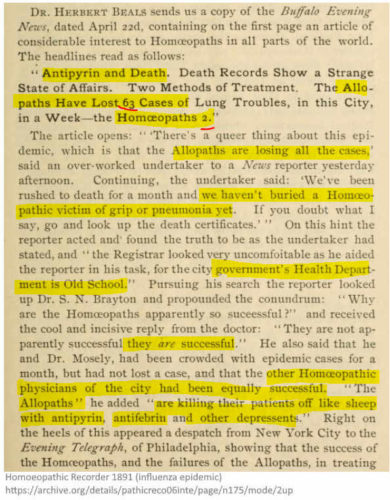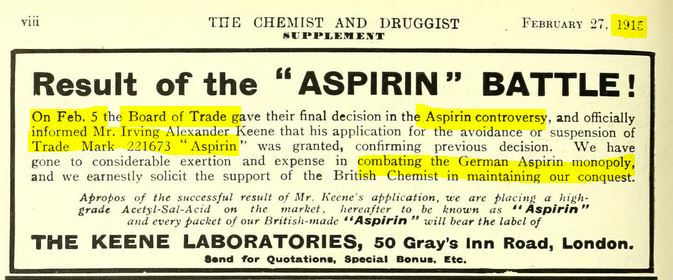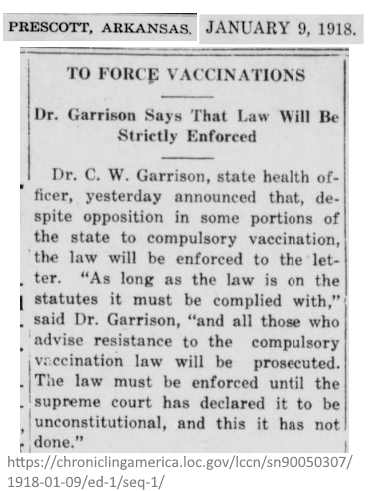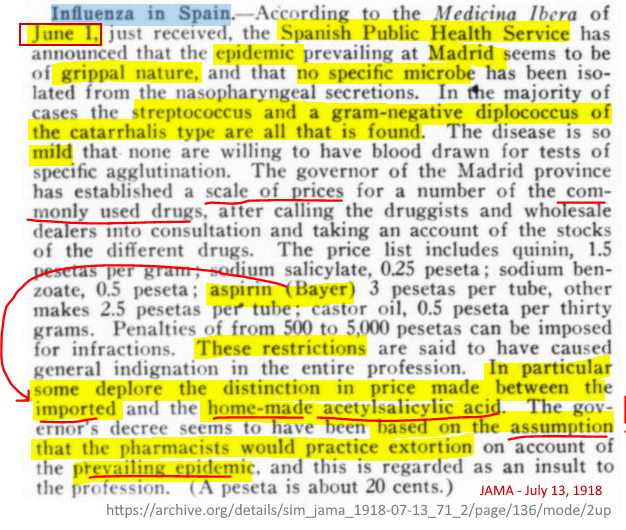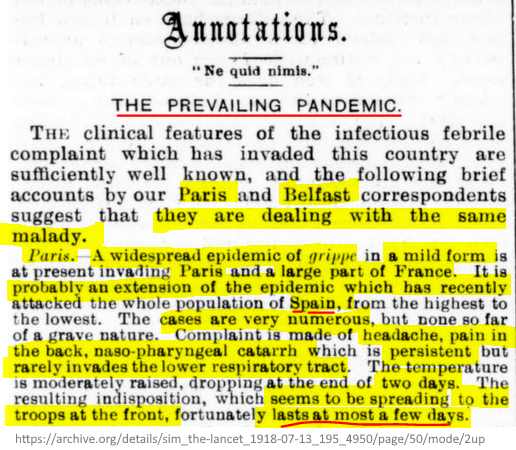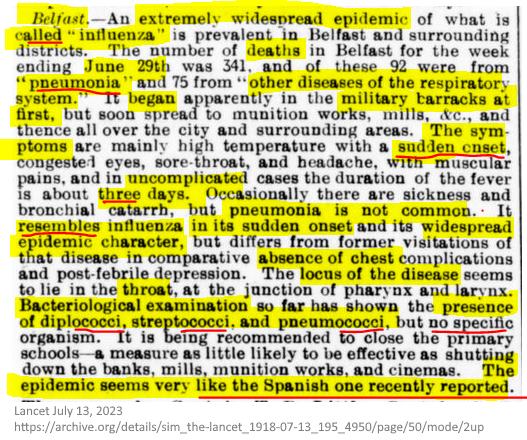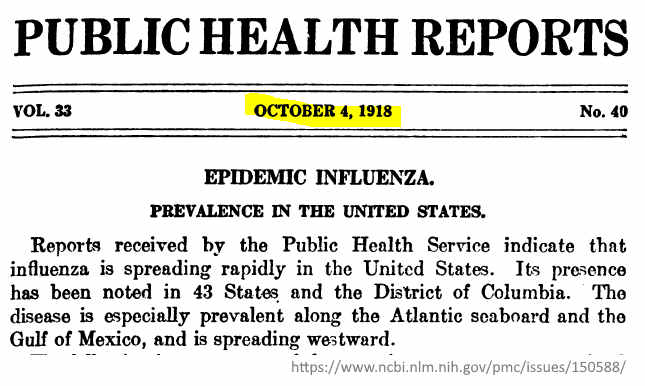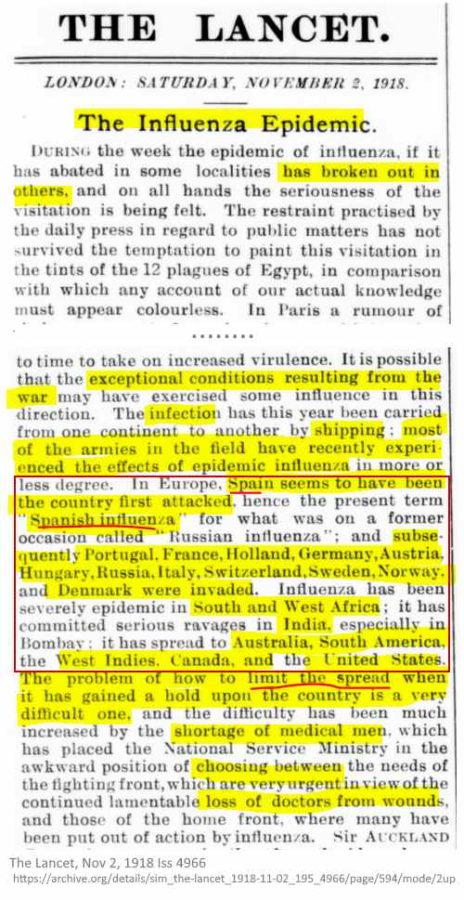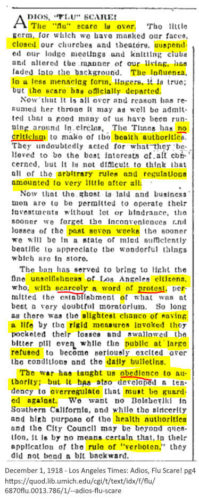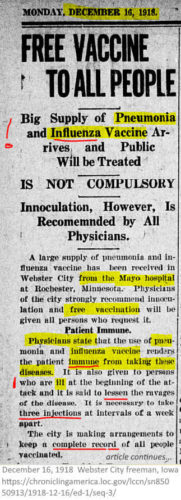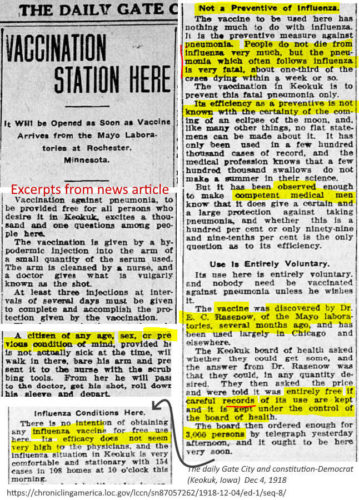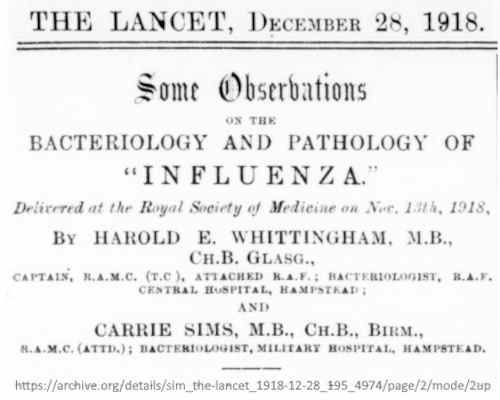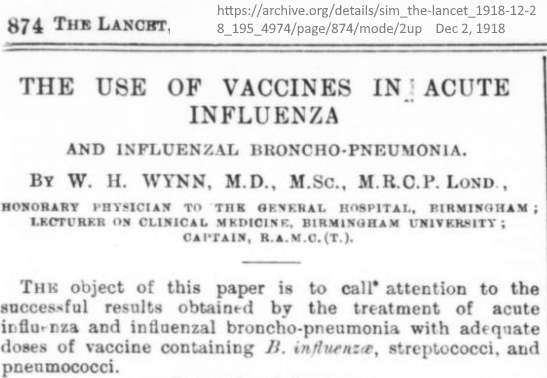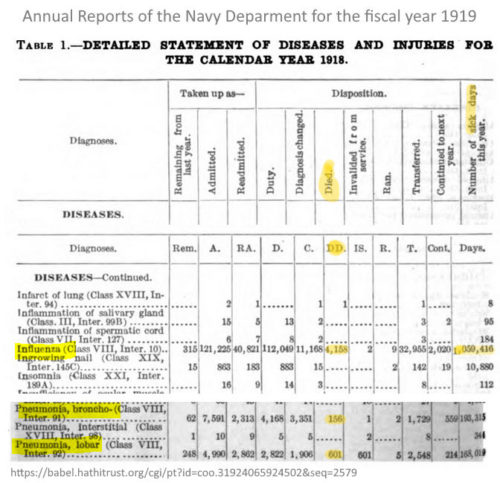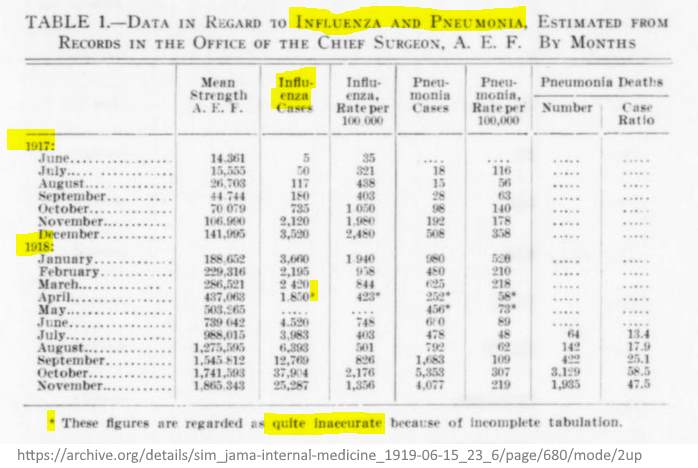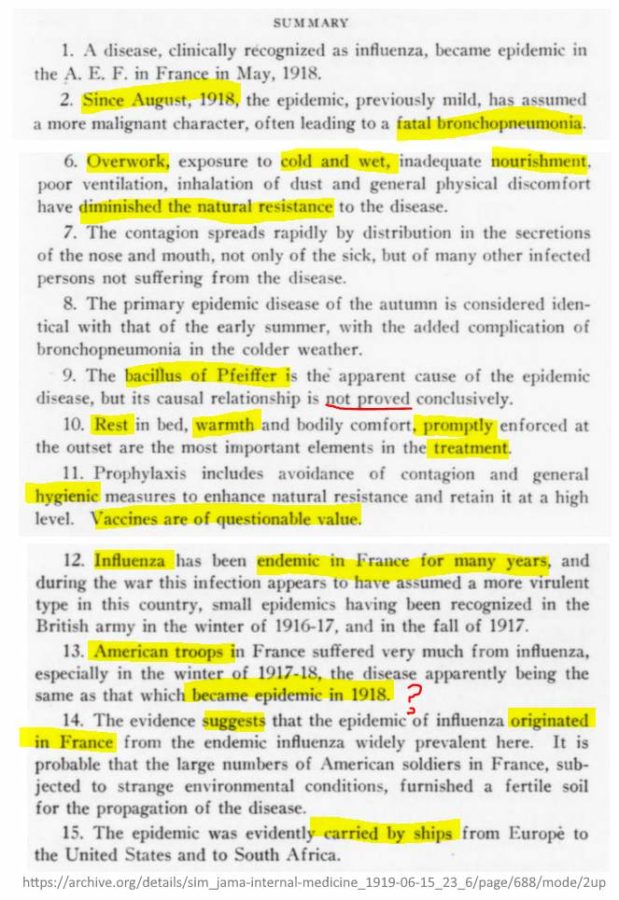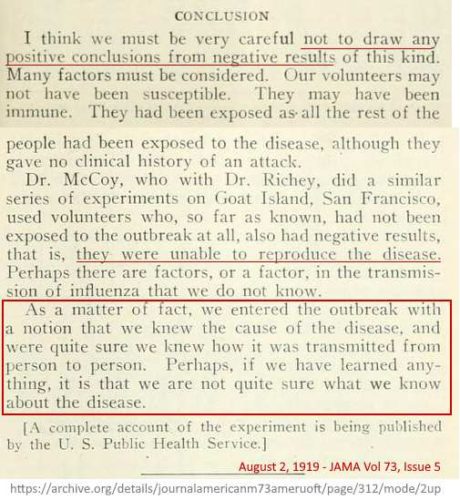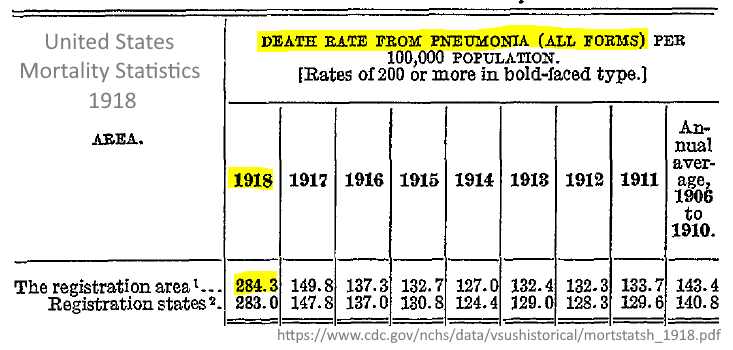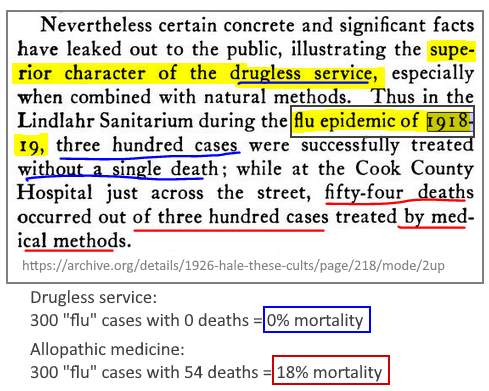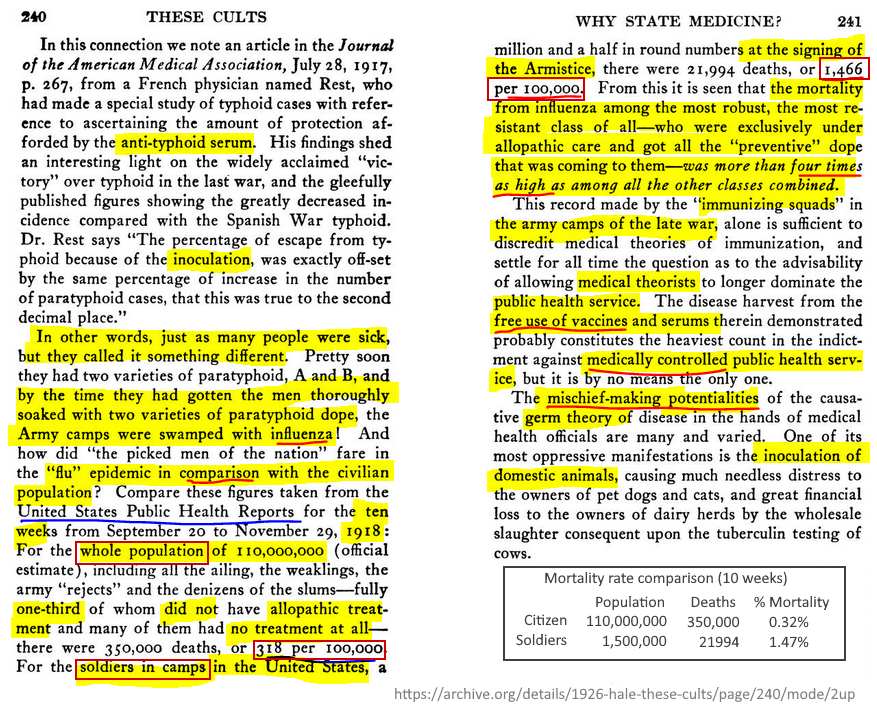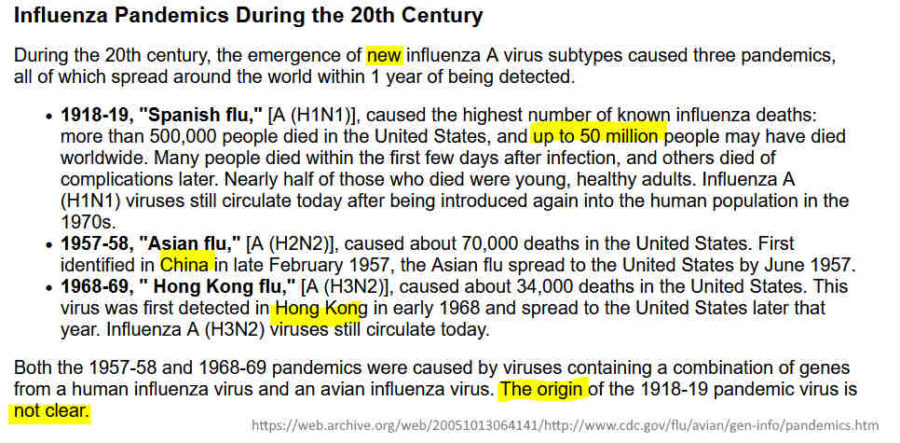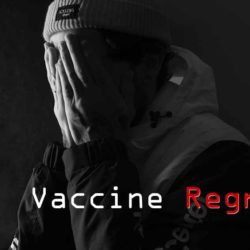We are told the 1918 Influenza Pandemic was the worst pandemics in our history. It is commonly called the “Spanish Flu” pandemic, I will call it the 1918 pandemic. We are told that the 1918 pandemic was caused by a novel influenza virus which killing an estimated 50 million people world wide, at a time when the population was about 1.8 billion, which equates to an approximate 2.77 percent mortality rate.
Depending on what publication you read, this global death toll estimate ranges from 17 million up to as high as 100 million or from 0.94% to 5.55% mortality respectively!
The US CDC say there is no universal consensus regarding where the virus originated, though it spread worldwide and was “first identified” in the United States in military personnel in spring (March-May) of 1918, the peak of deaths hit in September 1918, and subside in early 1919, officially spanning for a period of 10 months.
On hundered years on, at the October 2019 Event 201 coronavirus pandemic simulation they predicted, in their scenario, 65 million deaths would occur world wide without a vaccine, a figure curiously close to the “1918” number! But based on 2019 global population of approximately 7.8 billion, the 1918 pandemic would have had a higher death toll percentage (just an observation). As it turned out the “surprise outbreak” predicted for 2020 amounted to 6.89 million deaths that had “COVID-19” documented on their death certificates, by July 2023. (Were they actually deaths from a virus or deaths with a PCR positive test?)
Why was the 1918 pandemic so fatal?
In an Infectious Disease paper there is the statement: “By the early 1990s, 75 years of research had failed to answer a most basic question about the 1918 pandemic: why was it so fatal? No virus from 1918 had been isolated, but all of its apparent descendants caused substantially milder human disease.”
- So why WAS the 1918 death toll so high?
- Was the cause an “influenza virus” if nothing was isolated?
- Why were all “apparent descendants”, of this influenza virus, milder in comparison?
- Is there another explanation for all of these?
So I’m curious, was it actually a novel influenza virus that caused so many deaths, or was there a perfect storm of events and interventions, that cascaded into so much tragic loss, and could deaths have been prevented? These are questions that I have, knowing the COVID-19 pandemic is not what we are officially told, as I have documented on this website, but was it also the case for the 1918 pandemic? That is what I want to explore and find out for myself. I knew very little about the 100 years-ago pandemic before starting this page, so lets see what I discover.
This page will document the research data points that I uncover, mostly from archived documents found online, and see where it leads me! I will also be writing about this on my substack, you can track this Hidden Knowledge HERE
The United States
I will concentrate my research on the United States as they documented the highest death toll for COVID-19 during 2020-21, double that of India, and I wanted to see how well they fared in 1918-19. As I come across interesting findings from other countries, including my own country, Australia, I will captured these also.
The US statistics reported 675,000 people of their population died during the pandemic, with cause-of-death either influenza or pneumonia, but curiously, just like in 2020-21 they had “comparatively few” other respiratory illness deaths during this same period, a “remarkable” finding.
Death statistics create FEAR
Blaming death on “one thing” provides an avenue to point blame and instil fear in a population. But was it really “the flu” that killed the people around the world in 1918 or was it the perfect storm of compounding circumstances that led to their demise, and a virus got the blame? I’m on a journey of discovery. I’ll place what I find here!
Dr Fauci et al published a paper that revealed most of the 1918-1919 pandemic deaths were from bacterial pneumonia [1, 2], at a time when mask wearing was prolific, but the influenza virus got the blame.
But what happened leading up to 1918 and during the pandemic period that could provide clues to factors that contributed to such high death numbers. Because just like in 2020 where those doctors who treated “the patient” and did it early, they had minimal to no deaths from COVID-19, compared to The Hospital System, the very same thing happened during the Spanish flu! Those who sort assistance from “regular” doctors of “Medical Science” had a higher death toll!
Medicine’s “supremacy” is waning over the minds of the masses
Some key findings on this page:
- “Regular” physicians of “Medical Science” did not know how to treat influenza or pneumonia in 1918 – they experimented with their “coal tar” derived drugs.
- In the U.S. during 1918-19 deaths from other respiratory diseases, other than influenza and pneumonia, “were comparatively few” or effectively disappeared – REF Just as “the flu” disappeared in 2020!
- Bacterial pneumonia was the major cause of death, as documented in the US vital statistics as well as according to lung tissue analysis published in 2008 by (the vaccine trio) Morens, Taubenberger and Fauci
- Wearing of cloth masks were promoted by board of health to save lives – “99% proof against influenza”.
- Aspirin came off-patent in February 2017, it was available over-the-counter, and was taken in overdose amounts, a practice encouraged by some physicians “if a little is good, a lot more is better” mindset.
- Aspirin in high doses affects the heart and pneumonia sets in!
- [Edit April 2024 – Aspirin and pandemic mortality (2009) PAPER]
- “The Cult” practitioners referred to as “quacks” had lower mortality rate under their treatment guidance
- Mortality rates of fraction of 1 percent (0.25%) under the “quacks” compared to 6-7% with as high as 50% under the “care” of regular physicians.
- 1995 Case Fatality Rates (CFR) were estimated >2.5%, compared to <0.1% in other influenza pandemics
- Newspaper advertising was prolific for instilling fear. Throughout was a mass campaign for the “cure-all” Aspirin!
- Experiments failed of “influenza” sick, failed to infect with mucus (cough, sneeze etc) healthy people. Even though they did not know what the “pathogen” was, a sick person failed to infect a healthy person. The illness called “influenza” was not contagious.
- Historical and epidemiologic data are inadequate to identify the geographic origin of the virus, thought it may have began in 1915 – READ
- As “influenza” spread across the US in Sept/Oct 1918 “the limitations of modern medicine became evident.” states the CDC – REF
Vital Statistics:
These are but a few points discovered so far, as more comes to my attention I will place in the timeline below
Links will appear in chronological order
Note: This order is opposite to how I catalogue data on many other pages on this website. I want to build the picture…for my own benefit as well. This chronology reveals a fascinating order of events. Links are continuously being added. Use them for your own research.
1891
1891 – Homoeopathic Recorder 1891 (influenza epidemic in United States) pg 143: “Antipyrin and Death. Death Records Show a Strange State of Affairs. Two Methods of Treatment. The Allopaths Have Lost 63 Cases of Lung Troubles, in this City, in a Week — the Homoeopaths 2.” –READ, CREDIT
In this epidemic “of Grippe a new drug made from coal tar, Antipyrine, was responsible for many deaths from its depressant action upon the heart” – They mean 1890’s influenza “grippe” epidemic.
Antipyrin was patented in 1883 – WIKI
It was incorporated in almost every prescription, but it has practically disappeared from use by the next influenza epidemic in 1918, “mainly from its positively dangerous character and also from its worthlessness”
“In the late Influenza epidemic [1918] the same history was repeate in the use of Aspirin and Salol [Phenyl salicylate] by highly educated physicians whose knowledge of the art of treating the sick was in inverse ratio to their scientific attainments in medicine.” – (1921) REF
“…it would be impossible to explain the fabulous consumption of Antifebrin and Antipyrifi during the recent gigantic epidemic of influenza.” (1892) – REF
Two influenza epidemics in a row (1890-91 and 1918-19) where death were iatrogenic and not so much due to “influenza” – few died under homeopaths, and many came to homeopaths after treatments failed under the Old School allopath.
1889
November 2, 1889 – The Medical Record | New York: “Electrical Injuries” by Charles Dana – READ,
- A “curious epidemic of influenza in Russia” whre practically everybody catches this disease which lasts 3-4 days and causes great annoyance – READ
1890
1890 – American journal of public health: Comments from an Influenza and Pneumonia symposium held in 1916 refrences the unusual influenza from 1890 – READ
- “In the year 1890 ther was a sever outbreak of so-called influenza or grippe, an acute infection, presenting different symptoms from the ordinary respiratory infections, and everywhere accepted as a disease entity. From that time to this “influenza,” so called, has figured annually in our death-rates…Contrary to what one might expect, there seems to be no increase number of deaths from bronchitis and pneumonia in the years when the influenza mortality is the highest”…The great decline [in death rates] may be more apparent than real, for it is probable that many cases which in 1890 were credited to pneumonia would today be more carefully diagnosed and credited to malignant diseases, heart disease, nephritis etc.” Recent grippe failed to reveal the influenza bacillus. “Rather the indication is of infection with a streptococcus or pneumococcus of especial virulence.”
- Newspapers called this new and fatal disease in children “acidosis” the symptoms described o Page 313 could be radiation symptoms?
- Consider Quite Suddenly the world became electrified from 1889 and a different respiratory disease appeared – TIMELINE
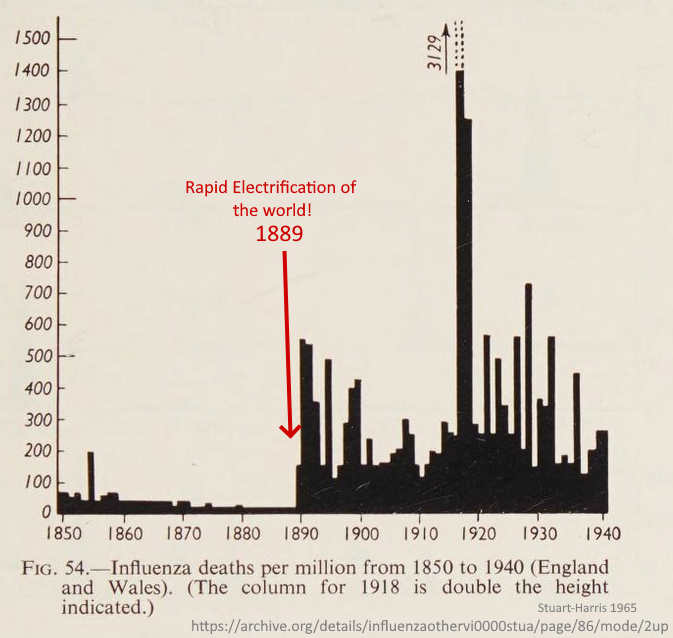
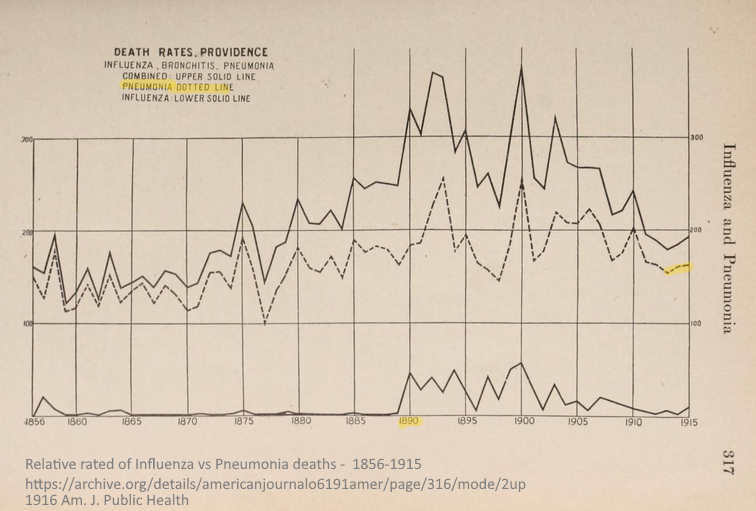

1897
August 10, 1897 – Notes: Acetylsalicylic acid (ASA) is discovered (Aspirin precursor)
- Felix Hoffman a scientists working for “Farbenfabriken vorm. Friedr. Bayer & Co.”, a German dye manufacturing company, synthesised acetylsalicylic acid (ASA) which became known as Aspirin the “drug of the century,” – READ
- “It was mostly by chance that he made a discovery of historic significance on August 10, 1897. By acetylating salicylic acid with acetic anhydride, he succeeded in creating acetylsalicylic acid (ASA) in a chemically pure and stable form”
- Hoffman worked under the direction of Arthur Eichengrün. Only after Hoffman’s death was credit given to Hoffman alone, which Eichengrün, a Jew, challenged in 1944 from inside a concentration camp – REF
- The trademark name A-spir-in is derived from “a” for acetyl, “spir” from the spirea plant (a source of salicin) and the suffix “in,” – REF
- Aspirn was more palatable than Salicylates or Salicylic acid.
- Bayer were already the manufacturer of Heroine hydrochloride – IMG
1908
1908 – The Homeopathic Recorder: Some Peculiar Cases of Influenza-Pneumonia by Dr G. Sieffert – READ
- “Somewhat striking in my cases was the frequency with which the left lung was affected, while usually it is the right side which, by preference, is the seat of inflammations. I may not mistake in stating, that the character of the pneumonias caused by influenza is gradually changing and that instead of the bronchial pneumonias, which used to be frequent, the lobar type is decidedly becoming more numerous.” – REF
1913
1913 – American Journal of Public Health – The Bacteriology of Influenza – READ (pg 95)
- “The view that influenza bacillus [Pfeiffer’s bacillus, known today as Haemophilus influenzae] is a necessary factor in the production of this disease is steadily losing ground” says the New York Medical Journal (Nov 23, 1912). Many cases presenting the characteristic symptomology fail to show the pressence of the grip bacillus, while on the other hand the organism is found in conditions which fail completely to present the characteristic features of the disease. …There is, in fact, good ground for Leede’s belief that “influenza is a symptom complex which may be evoked by different kinds of bacteria, the most prominent of which is the pneumococus. Hence the need of always being on our guard against pulmonary complications in these cases.” [as was experienced 1918]
1914
August 22, 1914 – The Chemist and Druggist (reported in The Times London): – READ
- “Probably the British public is not aware that nearly all the so-called synthetic drugs, such as antipyrine, phenacetin, aspirin, chloral, and sulphonal are made in Germany. So also is the artificial sweetening agent, saccharin, as well as important antiseptic agents, such as salicylic acid, and to a considerable extent also the alkaloids quinine, morphine, cocaine, etc.”
- Manufacture of Salicylic Acid – READ
1915
February 5, 1915 – Britain Board of Trade – Trade Mark 221673 “Aspirin” – combating the German Asprin monolpoly – READ, Aspirin ads in Britain – HERE, HERE, HERE
1915 – In 1915 the Public Health Service released a code book for telegraph messages – to prevent panic if information about an epidemic was transmitted – “A telegraphic code for the use of the united states public health service, prepared under the direction of the Surgeon General” – READ, CDC – CREDIT
1917
February 27, 1917 – Bayer’s Aspirin comes off patent – READ
- German company Bayer owns the trademark for “Aspirin”, and the US patent for the product. It is an over-the-counter drug, which is heavily advertised in the newspapers throughout 1917. There is a manufacturing plant in New York.
- When America entered World War 1 (April 1917), the German company, who made Aspirin in New York, had it’s assets seised. The rights were sold, that company claimed to have the only authentic product.
- Generic Aspirin product (they were allowed to use the trademark) flooded the market. It was available over the counter. Newspapers were flooded with Advertisements. People took more than the label suggested. Doctors promoted more than the labels suggested!
1918
1918 – CDC: In the 1918 pandemic, the militarised “Public Health Service was dominated by the Commissioned Corps, a mobile cadre of uniformed and ranked medical professionals….- ARCHIVE, TIMELINE
- “In the late nineteenth century, physicians flocked to join the PHS because it offered job stability and a regular paycheck.” They were all white males in 1918. These US PHS officers were stationed all over the world. [So white, male physicians in uniform were calling the medical shots in the 1918 pandemic]
- “Women and minorities could, however, work in the PHS as civil servants and many did so—as physicians, nurses, biologists, pharmacists and sanitary engineers.”
- According to Allopathic physicians at the time and the CDC “Because few diseases could be cured, the prevention of disease was central to the PHS mission.” i.e. vaccination for everything.
- The weekly Public Health Reports is the official journal of the Office of the U.S. Surgeon General and the U.S. Public Health Service. – REF, Reports ARCHIVE
- Influenza was not a “reportable” disease at this time – REF
- “Because patients experienced symptoms not traditionally associated with influenza, physicians found the disease especially difficult to diagnose in 1918.” Allopathic “practitioners had only a limited ability to treat diseases” – REF
- Public places like theatres closed – POSTER
January 1918 – To Force Vaccinations – Dr C. W. Garrison, state health officer states the law will be strictly enforced – READ, READ2, Public school – READ, Maryland April 1918 – READ,
- June 7, 1918 – Rock Island Argus: Health Talks – Vaccination: “is the most unscientific prophylactic procedure in use in civilized communities at the present time – no one knows what vaccine is – and I just hate to vaccinate any one, yet there is no getting around the overwhelming evidence that vaccination prevents smallpox …Let all who will be vaccinated early and often, and let the rest be pock-marked if they wish” – June 1918 – READ
February 28, 1918 – The Audubon Republican (Iowa News) – Facts on Vaccination (TWO Page spread by M.O. Kingsbury, Chiropractor, Audubon, Iowa) – READ, PAGE2
- Objective “to educate the laymen as to facts regarding vaccination, and its results….[from] facts and reports from statistics gathered by statisticians, and others who are interested, and those who have been awakened by the fatalities and mortality caused by vaccination…smallpox and vaccination”
- “In talking with two of our supposedly well read and intelligent citizens, they both made the remark that they never heard of vaccination being injurious to the human body. Or heard of any mortality directly, or even indirectly, caused by vaccination” Many others assume vaccination is alright simply because health boards recommend it!
March 30, 2018 – United States Public Health Service | Public Health Reports April 5, 1918, p502: “On March 30, 1918, the occurrence of 18 cases of influenza of severe type, from which 3 deaths resulted, was reported at Haskell, Kans.” – PDF, IMAGE, CREDIT
April 15, 1918 – “The earliest reported outbreak of epidemic proportions in the A. E. F. was that which appeared about April 15, 1918, at Rest Camp 4 in Base Section 2, near Bordeaux, reached its height on April 22 and ceased on May 5.” – pg 675 – REF
May (mid) 1918 – “By May, 1918, there was in Spain a widespread epidemic which received much publicity” – REF, REF2,
- “On the information thus far at hand it may be stated that from the beginning of the outbreak the disease appeared to have the characteristics proper to all the epidemics recorded in history under the name of influenza, grippe, or trancazo (beating with sticks). The great infectivity of the disease, its short duration, and its relatively benign character, are marked features…” [symptomology is described within] The author associates Pfeiffer bacillus with most cases either initially or following disease progression- pg 1924 REF
- Mortality was “greatest among adults from 20 to 39 years of age”…
- “Those most heavily struck by the disease have been the cardiacs and the tuberculous; the latter have paid the heaviest tribute to the disease”
May 1918 – “A disease, clinically recognized as influenza, became epidemic in the A. E. F. in France in May, 1918.” – REF
June 1, 1918 – Reported in: Journal of the American Medical Association (JAMA) | Vol 71, No 2 (July 13, 1918): Influenza in Spain – Pg 136 – READ
- It was reported in JAMA that the Spanish Public Health Service had “announced that the epidemic prevailing at Madrid seems to be of grippal nature“, the information was from Medicina Ibera published June 1, 1918. Grippe is the era’s common term for “influenza”.
- Just as interesting is “no specific microbe had been isolated” and “the disease is so mild”. But clearly the nature of this incident prompted the Madrid governor to put a cap on drug prices. Where Bayer’s aspirin is called out by brand name.
- I suspect this is the first account of “influenza”, and why the 1918 pandemic was referred to as “The Spanish Flu“.
July 2, 1918 – Reported in: Journal of the American Medical Association (JAMA) | Vol 71, No 2 (July 13, 1918): Influenza in Spain – Pg 136 – READ
- “Epidemic of Influenza—The report came from London, July 2, that the influenza epidemic that has been so prevalent in Spain has entered England, is spreading rapidly, and has already reached the midland counties where schools have been closed and many mines are in danger of being shut down.”
July 13, 1918 – The Lancet | Issue 4950: The Prevailing Pandemic – READ, Reports of grippe in Paris (France) and Belfast (Ireland)
- “The epidemic seems very like the Spanish one recently reported”:
- Interestingly Belfast is reported in poor health – Oct 1918 – READ
July 13, 1918 – The Lancet | Vol 195 Issue 4950: The Absence of the Bacillus Influenza in the Exudate from the Upper Air-Passages in the Present Epidemic – Captain Little et al Canadian Mobile Laboratory, Pg 34- READ
- “Is the present widely spread epidemic one of influenza or is it something new?” The symptoms are described and they are not typical influenza
- “The most striking symptoms are: Sudden onset with chills, severe headache with pain in cervical, dorsal, and lumbar regions, also pain in limbs and general malaise. The face is somewhat flushed and herpes labialis is to be noticed in a few case…”
- “In conclusion, we wish to point out that although this epidemic has been called influenza for the want of a better name, yet in our opinion it cannot properly be considered such for the following reasons:”…READ
- “The organism of influenza—viz., Bacillus influenza—was in all cases absent and there was present with no exception a Gram-positive diplococcus.” etc
July 13, 1918 – The Lancet | Vol 195 Issue 4950: Outbreak of an acute febrile disease in three factories and and industrial school in Glasgow – By Dr. A. MAcLEAN pg 36 – READ
- “During the first week of May of this year an acute febrile disease with symptoms resembling those of influenza invaded three factories and one industrial home for boys in Glasgow. The three factories accounted for 420 cases, the industrial school for 16. The disease was of a very mild type, and was characterised by sudden onset, severe headache, prostration, occasionally extreme, and rapid recovery usually in 2-4 days.”…
- “The bacillus of influenza is invariably absent“
July 27, 1918 – The Lancet Vol 195, Issue 4952: On a Method of Preparing Medium for the Culture of Pfeiffer’s Influenza Bacillus that gives profuse growth and is to a marked degree selective for this organism – John Matthews – READ Pfeiffer’s bacillus is the common name for the alleged influenza causing agent B. influenze (Pfeiffer) – (which should actually be a virus not bacillus – “Gram-positive, rod-shaped bacteria”)
- “In view of the prevailing pandemic of influenza it seems a fitting time to publish a short account of this peculiarly valuable medium…The method consists in the use of blood digested by trypin, prepared as follows…”
- “The medium grows influenza freely from the first culture, and it is to a marked extent selective. Thus, it inhibits pneumococci entirely and in a large measure streptococci and other Gram-positive organisms, but apparently favours staphylococci.”
July 27, 1918 – The Lancet Vol 195, Issue 4952: The Bacteriology of the Prevailing Pandemic – To the Editor of THE LANCET – READ
- Re Canadian report above “According to verbal report, investigations of other bacteriologists with the B.E.F. in France tend to support the view that the present pandemic is due to infection by Pfeiffer’s bacillus, and therefore truly influenza.”
July 27, 1918 – The Lancet Vol 194, Issue 4952: Broncho- Pneumonia in Army Camps pg 120 – READ [could these be “influenza” like illness]
- An important paper on the virulent type of pneumonia observed in Army camps was read by Dr. W.G. MAcCALLUM, of Johns Hopkins University, Baltimore. This disease seemed likely to be the cause of a large amount of sickness and death. While numerous cases of lobar pneumonia had occurred, the most noteworthy was a type of bronchopneumonia due to infection with a hemolytic streptococcus.
- The prominent symptoms were sore throat, swelling of the larynx, and alteration of the voice owing to deep ulceration of the vocal cords. The fluid which collected in the pleural cavity was slightly turbid, at first straw coloured, becoming later brown, and then purulent and thick….Post mortem the lungs were found distended with air and containing hard peri-bronchial nodules as large as peas, resembling miliary tubercles.
August 1918: “Aspirin Advertisements in August 1918 and a Series of Official Recommendations for Aspirin in September and Early October Preceded the Death Spike of October 1918” – REF, SOURCE, PDF
August 10, 1918 – Lancet Vol 195, Issue 4954: Bacteriology of the “SPANISH INFLUENZA“, as reported from Deutsche medizinische Wochenschrift – READ
- The pandemic of influenza has not spared any single part of Germany. … Relapses and fatal pneumonias are particularly noted.
- Frankfort his failure to detect Pfeiffer’s bacilli in any of the few cases which he had thoroughly examined. In practically all cases there were found, however, large numbers of a Gram-positive coccus—often in a pure culture or in symbiosis with pneumococci. The diplococcus tended to develop involution forms and to grow in very long chains in the condensation water. He regards them as agents of a secondary infection in the “Spanish disease”
September 1918 – CDC: The Great Pandemic – describing course of a “mixed infection” beginning like influenza- ARCHIVE
“This epidemic started about four weeks ago, and has developed so rapidly that the camp is demoralized and all ordinary work is held up till it has passed….These men start with what appears to be an ordinary attack of LaGrippe or Influenza, and when brought to the Hosp. they very rapidly develop the most viscous type of Pneumonia that has ever been seen. Two hours after admission they have the Mahogany spots over the cheek bones, and a few hours later you can begin to see the Cyanosis extending from their ears and spreading all over the face, until it is hard to distinguish the coloured men from the white. It is only a matter of a few hours then until death comes, and it is simply a struggle for air until they suffocate.
It is horrible. One can stand it to see one, two or twenty men die, but to see these poor devils dropping like flies sort of gets on your nerves. We have been averaging about 100 deaths per day, and still keeping it up. There is no doubt in my mind that there is a new mixed infection here, but what I don’t know.”
A physician stationed at Fort Devens outside Boston, late September, 1918 – CDC
September 26, 1918 – US Navy: DIVISION OF SANITATION, Washington, D.C. – Influenza “grippe” is now spreding over the country in epidemic form (description of disease, charts and other data) – Influenza – SECTION1, INFLUENZA STATISTICS, ENTIRE NAVY – SECTION2, SECTION 3, CREDIT
- “At the beginning of the disease a cathartic, such as 21/2 or 3 grains of calomel [mercury], followed by a seidlitz powder or epsom salts, is useful. Aspirin in 5-grain doses is useful for pain, but do not take large doses of aspirin, phenacetin, or other medicines. Send for the doctor.”
- “Vaccination against influenza is partially successful.” [They had the wrong pathogen Influenza bacillus/Pfeiffer’s bacillus].
- “controlled, vaccination experiments were without value”…555 men given “three inoculations of a Pfeiffer bacillus vaccine prepared at the United States Naval Hospital, Chelsea, Mass….third inoculations were completed October 5, 1918” with 800 controls – 9% of vaccinated contracted the influenza compared to 5% of controls!
- Another test with several thousand men of those that contracted influenza 12.8% were unvaccinated and 15.9% had received one to four inoculations of Pfeiffer bacillus vaccine
- “vaccination had no marked influence upon the course and severity of the attack”
September 28, 1918 – The Lancet | Vol. 195 Iss. 4961: Notes on the Symptomatology and Morbid Anatomy of So-Called “Spanish Influenza” with special reference to its diagnosis from other forms of “P.U.O” – E. Rivaz Hunt – pg 420 – READ
- The symptomatology of “Spanish influenza” is characteristic, and in view of the extreme prevalence of this disease at present…:
- The incubation period appears to be short, about 3-4 days. The mode of onset is characteristically sudden….
- The earliest symptoms are usually shivering, pains in the limbs and back and very severe headache—generally, but not invariably, frontal in situation—and sore throat, and in almost all cases an irritating severe cough is also complained of….The appearance in most cases is quite characteristic. The patient lies curled up in bed in a drowsy condition, with flushed face and injected conjunctiva, but there is little coryza, and physical signs, in the early stages at any rate, are remarkable by their absence.” Some have a rash.
- A small percentage of patients develop serious pulmonary complications, and the pneumonia arising in these cases presents several distinctive features. It is of a mixed lobar and broncho-pneumonic type….In some of these influenzal pneumonias the toxemia is severe, and death rapidly ensues from acute heart failure.
- The heart condition of a very large proportion of these cases of ‘‘ Spanish influenza” is interesting…It is noteworthy that in a large proportion of cases examined post-mortem here myocarditis was found, and more or less dilatation of the heart was constant…
- The onset of pyrexia [fever] is very sudden, the temperature rapidly rising to 103° or higher. The duration of pyrexia is generally short,…
- The pains of this type of influenza are very characteristic ; they are referred almost invariably to the muscles and soft tissues, and to a less extent to the joints rather than to the bones themselves….
- A blood count is of great value in helping to discriminate between the various causes of P.U.O. … In ‘Spanish influenza” the leucocyte count usually varies between 5000 and 9000 per c.mm….
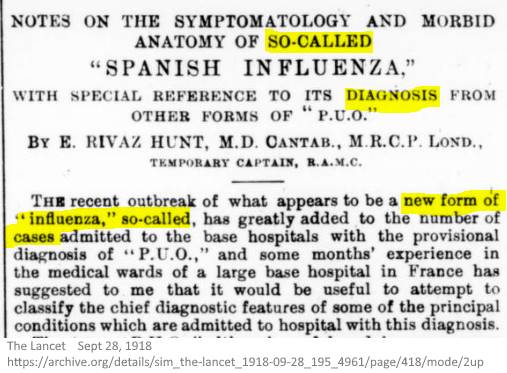
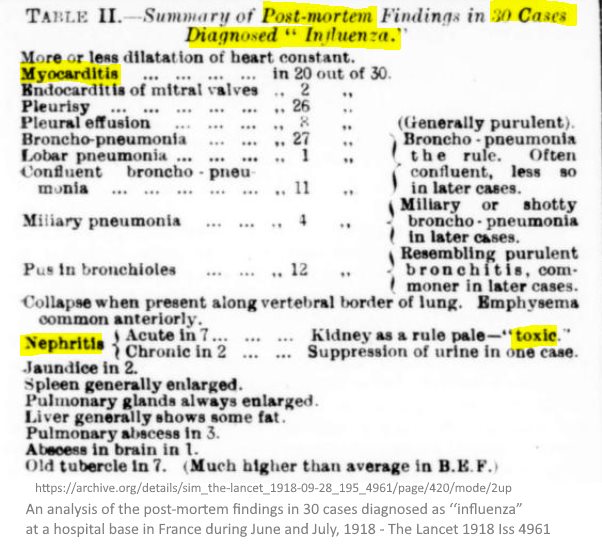
Note: 7 with acute toxic kidney.
September 1918 – Camp Lee, Virginia, USA – Testimonial from Camp Lee Hospital – after Aspirin was banned the “death rate came down very rapidly” – PDF [the more you learn!] (September was the influenza month at Camp Lee – REF)
My low death rate at Camp Lee was due entirely to the fact that I avoided the use of Aspirin absolutely. I was complimented by the chief medical officer as having the lowest death rate in the hospital. After the medical chief had noted the effect of Aspirin on the blood and the results which I was having in using Homeopathy he discouraged the use of Aspirin and the death rate came down very rapidly after that ruling.
Carleton A. Harkness, M. D. (a Homeopath) – PDF
- Surgeon General report from Camp Lee – Pg 756 and base hospital report pg 758 – READ, Camp overview pg 386- READ
- No mention of the Aspirin ban but (pg 758) “A system of rapid expansion and the avoidance of over crowding were perhaps the most important factors in successfully treating the situation” [perhaps!]
- (pg 757 – point #7): “It is very doubtful, as far as the influenza itself was concerned, whether any measures taken ultimately reduced the incidence of the disease. The quarantine seemed to have no ultimate effect, but did delay the appearance of the disease in the organizations so isolated”
- Note (pg 757): “all members of the command had their nose and throat sprayed daily with argyrol“. This is the only reference in the SG report to Argyrol (Mild Silver Protein anti-infective) yet this treatment was allegedly mandated by SG for all troops and then recommended to the public.
October 2, 1918 – EPIDEMIC INFLUENZA AND THE UNITED STATES PUBLIC HEALTH SERVICE pg 1821 – “In this emergency the Surgeon General called upon the Volunteer Medical Service Corps, the Red Cross, the medical and nursing profesions as a whole, and on the general plublic for personnel to helpcombat the epidemic.” – REF
October 4, 1918 – US Public Health Reports: Epidemic Influenza – Prevalance in the United States – PDF
October 5, 1918 – The Lancet | Vol 195 Iss 4962 : INFLUENZA IN INDIA.—There has been a widespread epidemic of influenza throughout India, introduced, the medical officers of health agree, through shipping. – READ
October 8, 1918 – Am. J. Public Health: THE USE OF INFLUENZA VACCINE IN THE PRESENT EPIDEMIC – READ, SOURCE
- Three strains (Carney, Navy and Devens) of influenza bacilli [BACTERIA] obtained from cases during the present epidemic have been used in the manufacture of vaccine.
- The technic used in the preparation of vaccine follows: 1 1/2 per cent agar has been prepared from meat infusion (beef hearts) with glucose, and made 1 per cent acid in plenolphthalein….Three to five drops of human blood are added to each tube…We have prepared in this way up to 4,000 tubes of blood-agar per day
- The solution is mixed with “Three Cresols” – cresols are obtained from coal tar or petroleum
October 8, 1918 – Am. J. Public Health: THE EPIDEMIOLOGY AND BACTERIOLOGY OF INFLUENZA – Darling – READ, SOURCE
- MASKS justification: “The best evidence indicates that infection occurs through respiration, the causative organism being carried on dust particles and presumably lodging on the mucosa of the respiratory passages.”
- Quarantine and isolation not practical except in army as too many are infected. But closing things down could work!
- “The onset of the disease is very sudden, often in one to three hours the patient passes from apparent health almost to prostration.” Disease manifestation described
October 11, 1918 – US Public Health Reports: INFLUENZA: AVOID IT AND PREVENT ITS SPREAD. Instructions issued by the Department of Health and Sanitation Emergency Fleet Corporation – pg 1731 – PDF
- “The agents which cause the disease come from the nose and throat of infected persons. Some persons carry the infection without having the disease. [asymptomatic]
- Avoid needles crowding – walk to work
- Say in the open air and in the sunshine as much as you can
- Breathe clean air and plenty of it – keep window open when you sleep
- Use plenty of covering to keep warm and loose fitting clothes when awake
- Avoid coughing, sneezing, or snuffling persons and don’t do the same. “The firing range of the careless cougher or sneezer is at least 3 feet. Get beyond the ‘barrage’ of infected droplets.”
If necessarily attending the sick, wear a gauze mask over the nose an mouth. Wash your hands thoroughly after handling a person sick with grip and after handling anything likely to be smeared or sprayed with the secretions from the nose or mouth of an infected person - Wash you hands thoroughly
- Don’t use the napkin, towel, spoon ,for, glass or cup which has been use by another person and not washed
- Keep away from houses where there are influenza cases unless necessary for you to visit them
- Keep up you genera health – clean water, eat clean, wholesome food, sleep 7 hrs, regular bowels
- Buck up. Bee cheerful.
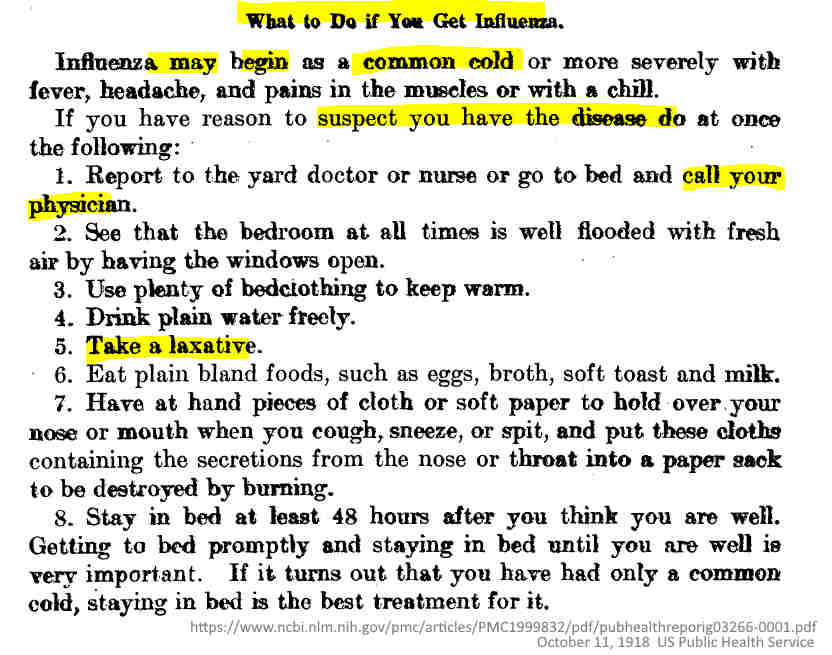
October 18, 1918 – The Sun | New York:…Conboy Releases Doctors and New Vaccine Promises Relief – READ, CONT
- “Physicians who were examing for the draft “will be released to combat the local epidemic”…”The Department of Health presented the results of experiments conducted with anti-influenza vaccine prepared by Dr William H. Parks, director of the bureau of laboratories in the department. They indicate that where the vaccine has been used there has been a sharp decrease in the number of new influenza cases….immunity from influenza has been produced by use of the vaccine it is the strongest possible indication that Pfeiffer’s bacillus is the cause of the disease.” [Which it was not!]
- 30,000 doses per day have been ordered!
October 23, 1918 – Daily Gate City news Iowa: Vaccinate Class One – Influenza vaccination “compulsory on the men going to cantonment” ” – READ
October 27, 1918 – US Senate Joint Resolution 63 (65th Cong., 2nd sess.): An act to establish a permanent reserve for duty in the Public Health Service in time of national emergency “such as that presented by the present epidemic of influenza.” – PHS Reports p1865 (the PHS is a military organisation)
October 1918 – Am J Pub Health: Weapons Against Influenza: Widwestern Health Department went East he received advise – READ
“When you get back home, hunt up your wood-workers and cabinet- makers and set them to making coffins. then take your street labourers to set the to digging graves”. If you do’ this you will not have your dead accumulating faster than you can dispose of them.”
- “Among the prophylactic measures have been employed in the Ease: the conventional precautions against contact infection, the face mask, and anti-influenza vaccine“
- Among the curative measures have been advocated: the open-air treatment, the use of serum from convalescent patients, and again, anti-influenza vaccine“
- “As for the vaccine…it has no therapeutic effect, that the prophylactic effect merits further investigation, and that no ill effects follow the use of the vaccine” [i.e. its safe but not effective!]
- While we wait for more conclusive statistics, the epidemic rages’ any community is, therefore, justified in employing the vaccine, for it is safer to gamble with the cost of preparing and administering the vaccine than with the lives endangered. It will be well to emphasize to the public that the vaccination is experimental, and is not compulsory; otherwise, in the event of its ultimate failure, the whole system of vaccination may be discredited by the public, including that against smallpox, typhoid etc.
November 1, 1918 – Public Health Reports Vol 33 No. 44: Epidemic Influenza: Reports received by the United States Public Health Service since the last issue… indicate that the epidemic is declining in a majority of the States. In some places conditions are approaching normal. … In a few States it appears that the crest has not yet been reached. – PDF
- “Up to and including October 26, a total of 86,045 deaths from influenza and pneumonia (all forms) since the beginning of the epidemic has been reported to the Public Health Service”
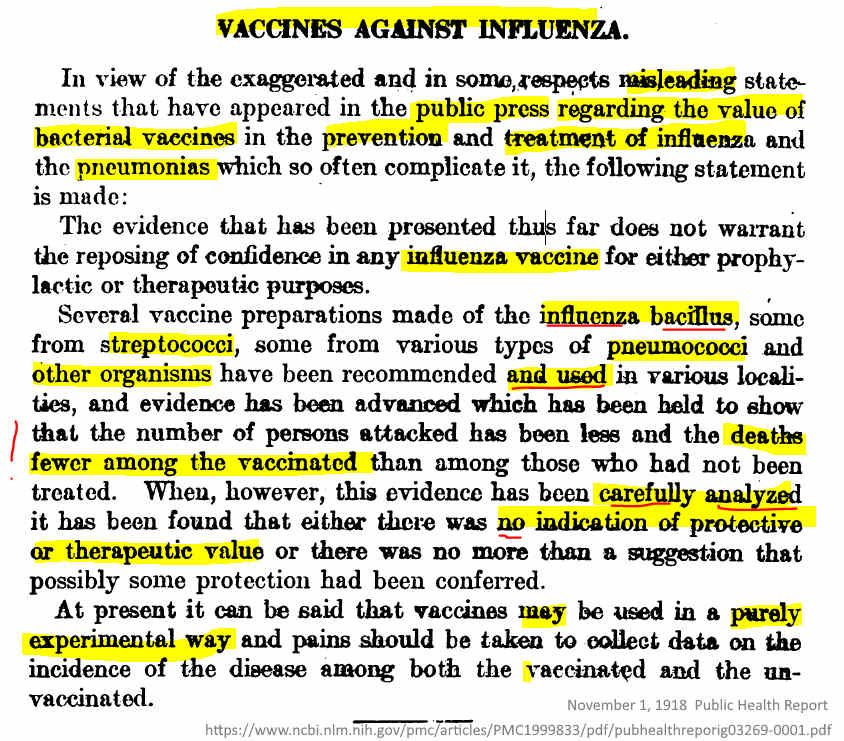
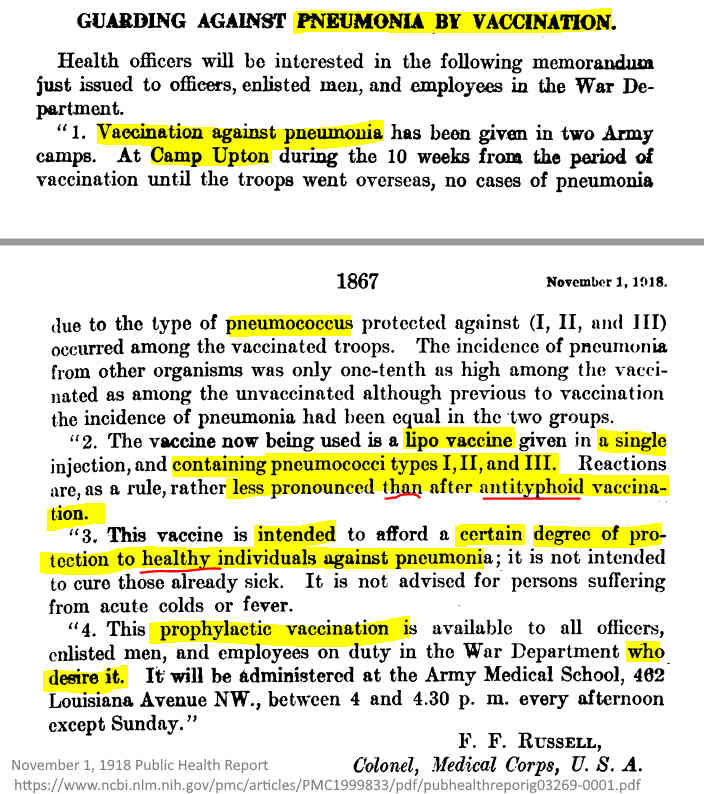
- CDC: In 1918 “practitioners had only a limited ability to treat diseases.”…”As a viral infection, influenza can be prevented by a vaccine and during the early weeks of the pandemic”. According to the CDC “many people believed that a vaccine against influenza was forthcoming. Although vaccines have been developed before scientists have ascertained the exact cause of a disease [i.e. the pathogen], medical researchers’ failure to ascertain and isolate the influenza virus did not bode well for the development of an influenza vaccine at this time.” – REF
November 2, 1918 – The Lancet | Vol 195 Iss 4966: Observations on a Small Localised Epidemic of Influenza with Special Reference to the incubation period – Foster and Cookson – READ, Nov 9, 1918 – The incubation period of influenza- READ
- “These observations illustrate two factors in the spread of influenza. Firstly, the narrow radius within which infection takes place ; secondly, the shortness and apparent punctuality of the incubation period. Both these factors help to explain the rapid spread of epidemic influenza.”
November 2, 1918 – The Lancet Vol 195, Iss 4966: The Influenza Epidemic – pg 595- READ
- The epidemic influenza has spread across the world, there are a shortage of doctors due to the war, and by this stage it appears most to the armies in the field have recently been infected.
- “In Europe, Spain seems to have been the country first attacked, hence the present term “Spanish influenza” for what was on a former occasion called “Russian influenza”!
- For the rest we may trust the Local Government Board and the local health authorities to do their best in the circumstances, but the work of prevention is largely dependent upon the people themselves. If those who feel ill would stay at home; if those who are well would avoid travelling in railway carriages with the windows closed or in unventilated trams and ‘buses; and, above all, if the public would forego picture palaces or other crowded places of amusement so long as the epidemic continues,
- STOP THE SPREAD: “… but the work of prevention is largely dependent upon the people themselves. If those who feel ill would stay at home; if those who are well would avoid travelling in railway carriages with the windows closed or in unventilated trams and ‘buses; and, above all, if the public would forego picture palaces or other crowded places of amusement so long as the epidemic continues, much would be done to limit the spread in populous centres.”
November 2, 1918 – The Lancet | Vol 195, Iss 4966: Correspondence – Influenza and Preventive Inoculation (and other letters to the Editor) pg 602 – READ, more information pg 609 – READ, Nov 9 – READ
- “I am personally supplying quantities of the vaccine to the military authorities through the Inoculation Department, St Mary’s Hospital” – The comment was referring Oct 26 article about vaccinating military – “Our Present Knowledge of Epidemic Catarrh.” – READ
- 50 cases of influenza were treated with “intravenous injections of oil of garlic. After determining on himself that 5 mins. of Oleum allii sativi could be given with impunity, he administered the oil to patients suffering from influenza in a 10 percent. solution, using equal parts of alcohol and pure ether as the solvent” [This is medicine of the time in action!!] – REF
November 8, 1918 – Public Health Reports Vol 33, Week 45 (pg 1913-1968) – READ, PDF
- ***Summary of the epidemic, includes reports from around the world.
- Table: Cases of Influenza and Deaths from Influenza and Pneumonia (All Forms) as Reported to the United States Public Health Service from page 1913
- INFLUENZA IN EUROPE. pg 1921 – Netherlands, Switzerland, Spain, Germany,
- Epidemic symptoms similar to 1889 epidemic (29 years earlier), elder less affected (natural immunity?) under 30’s hardest hit.
- SURE CURES FOR INFLUENZA…”The United States Public Health Service urges the public to remember that there is as yet no specific cure for influenza, and that many of the alleged “cures” and remedies now being recommended by neighbors, nostrum vendors, and others do more harm than good. The chief reliance must be on fresh air, nutritious food, plenty of water, cheerful surroundings, and good nursing.”
November 11, 1918 – Armistice day, World War 1 ended
Now what are they going to do with the left over vaccines?
November 15, 1918 – US PHS | Public Health Reports Vol 33, No 46 – DROPLET INFECTION EXPLAINED IN PICTURES – “The poster exemplifies the modern method of health education” teaching the public about “droplet infection in the spread of respiratory diseases” – READ
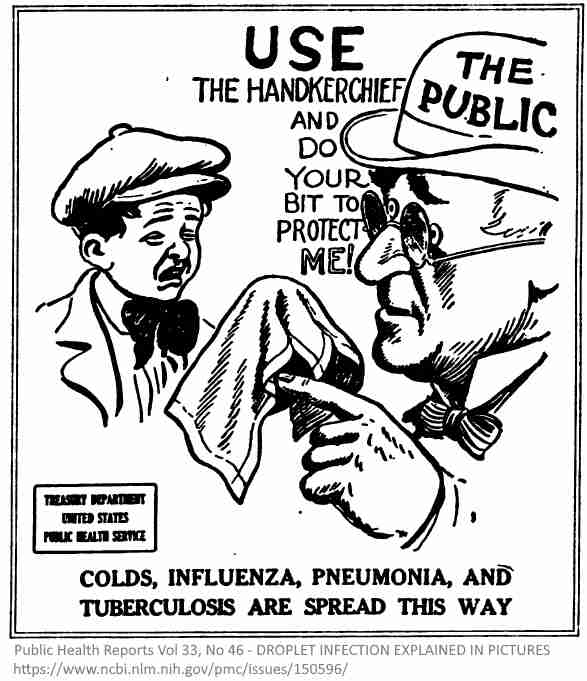
November 20, 1918 – The Washington Herald: Influenza, Epidemics and Vaccination by Chas M. Higgins, NY – READ (Suspend all compulsory vaccination soldiers, make vaccination voluntary to stop the epidemic!) [just a few notes from this very interesting article…pls read full article]
- Vaccination a proved cause of epidemics and a possible or partial cause of the present epidemic of influenza and pneumonia. Request the US War Department to suspend all army vaccination during epidemics and t make all vaccination wholly voluntary as it now is in the English army.
- “Now the act of ordinary vaccination [smallpox] is, in itself, an act of blood poisoning, pure and simple, and it is so classed in medical and statistical works as a form of ‘septicemia’ and one disease germ commonly found, with many others, in vaccine virus is the streptococcus, which is the chief germ found in all bad pus infections and abscess formations” (author provides ref in article)
- “Therefore, as the act of vaccination is simply the impregnation of the body and blood with a pus infection identical with ‘septicemia’ or ‘pyemia’ and as this infecting process is repeated at wholesale in the bodies of thousands and tens of thousands of men closely massed in camps, should it be any wonder if an epidemic of some sort of ‘septicemia’ should crop out at some time under such conditions?” [good question!]
- Could “…such world-wide, and million times repeated, acts of septicemic infection [various injections given]…prove to have some causative or conditional relation to the present world-wide epidemic of septicemic disease?“[so it appears this author has knowledge of mass vaccination amongst all soldiers, including the “multi-vaccinated” Germans]
- A variation of smallpox disease, without eruptions, presents like influenza!
- “In fact true smallpox might be described simply as influenza with eruptions and mild smallpox or vaccination as influenza without eruption…This…establishes a logical and medical ralation between vaccination and influenza…” they note US Battleship Ohio Dec 1913 where smallpox and influenza broke out at the same time – impossible initially to differentiate b/w.
- “the extensive wholesale and repeated vaccinations in the military camps throughout the world…indicate that this vaccine infection was now escaping from and overflowing its usual bounds and running wild as a world-wide epidemic infections…
- Reference made to Dr William Osler’s Modern Medicine (1913) – suggesting not to vaccination during epidemics – HERE
- Vaccination applied to smallpox. With the development of pneumonia (Mayo laboratory) and influenza anti-serum they referred to these products as “vaccines” for “vaccination”, thus they hijacked the terminology to now apply to injecting ANY pathogen/toxin to make the person immune to disease – HERE (now that the hypodermic needle was available!)
- Reference made to: The Vaccination Question in the Light of Modern Experience – An appeal for Reconsideration (London, 1914) by Dr Killick Millard, Medical Officer of Health for Leicester – READ (18 years since England’s Royal Commission report on Vaccination – and no serious attempt has been made for review)
November 22, 1918 – US PHS | Public Health Reports Vol 33, No 47 – READ
- EPIDEMIC INFLUENZA AMONG AMERICAN SOLDIERS ABROAD – from Weekly Bulletin No. 28, issued by the office of the chief surgeon, American Expeditionary Forces, October 21, 1918.
- “New replacement draft detachments arriving with each convoy have added the heaviest percentage of infected men per strength and have shown the highest percentage of complicating pneumonia.” Meningitis …increases soon after. [All incoming troops were heavily vaccinated]
- “It will be noted that in the American Expeditionary Force “the heaviest percentage of infected men per strength and the highest percentage of complicating pneumonias” occurred among newest placement draft detachments. Is it possible that the other men possessed a certain degree of immunity because of the earlier mild outbreak?
- ANTI-VENEREAL CAMPAIGN MUST NOT RELAX – The end of actual fighting in the world war does not lessen the necessity for the campaign against venereal diseases
- Gonorrhea and Syphilis [Osler], both bacterial diseases. All military were vaccinated with bacterial “vaccines”. How were these vaccine products made? If from ANIMALS, is this a possible source of contamination?
- [They obviously didn’t get control, as venereal disease was the justification for restructuring the US Public Health Services – a military organisation – TIMELINE]
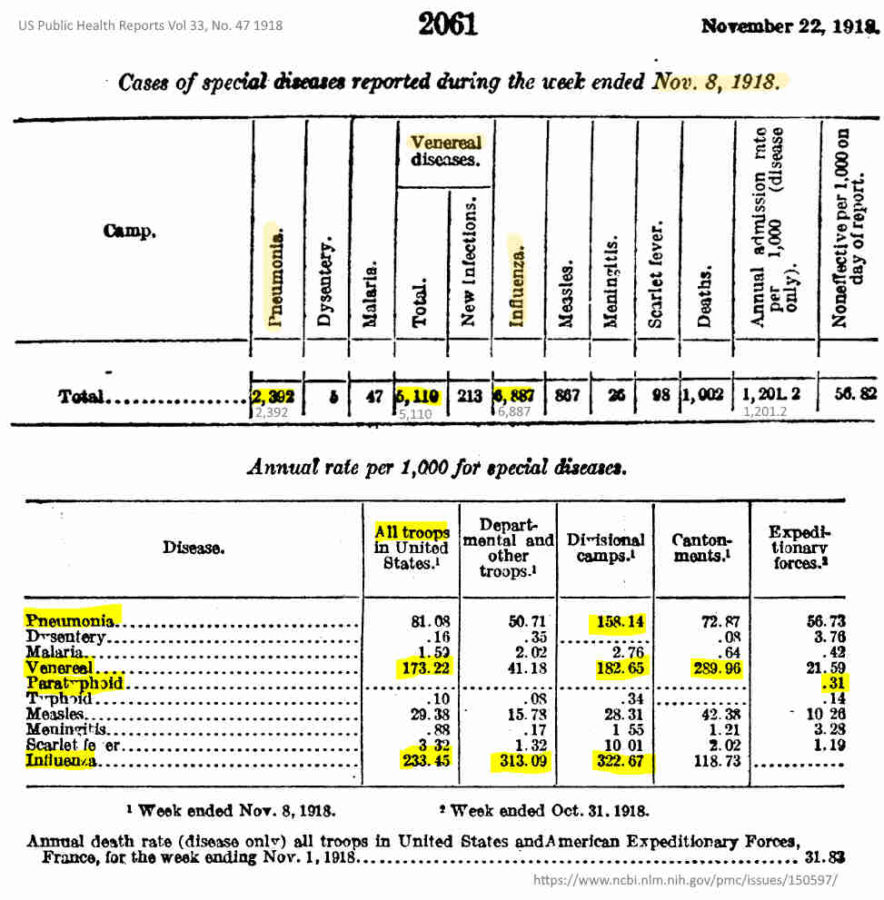
What was happening in Camp Dix? – source2
November 29, 1918 – US Public Health Reports Vol 33, No 48 – READ – “Influenza has ceased to be epidemic in many parts of the country”
November 1918 – American Journal of Public Health (NY): PUBLIC HEALTH NOTES – PDF, SOURCE
- “No Specific Cure for Influenza Yet Known. …The United States Public Health Service is besieged with inquiries as to the value in combating or treating “Spanish” influenza. Public interest in this form of treatment appears to have been aroused by newspaper accounts of the trials now being made of vaccines in various parts of the country.
- “..several different vaccines are now being tried. In and around Boston considerable use is being made of Leary’s influenza bacillus vaccine; in New York a vaccine made from various strains of influenza bacilli is being tested under the direction of Park, while in Chicago an entirely different type of vaccine, prepared by Rosenow is being tested. This consists of a mixture of pneumococci, streptococci, staphylococci, and influenza bacilli. The reports so far received do not permit any conclusion whatsoever regarding the efficacy of these vaccines or their relative merits.”
- The present epidemic has given rise to the publication of numerous “sure cures” and methods more or less plausible to the lay mind…. pseudo-scientific treatment, sometimes “isotonic sea-water,” sometimes”ozone therapy,” and again “harmonic vibrations.” and “sprinkle a little sulphur in each shoe every morning“…and more…
- The United States Public Health Service urges the public to remember that there is as yet no specific cure for influenza, and that many of the alleged “cures” and remedies now being recommended by neighbors, nostrum vendors and others do more harm than good.
December 1, 1918 – Los Angeles Times: Adios, Flu Scare! – READ [compare to COVID-19 pandemic!]
- December 29, 1918 – Influenza on Decline – Public health service reports – READ
December 6, 1918 – US Public Health Reports Vol 33, No 49 – READ
- THE INTRODUCTION OF COMMUNICABLE DISEASES BY RETURNING SOLDIERS
exotic epidemic diseases may not be carried into this counitry and spread with disastrous results…Among the diseases especially to be feared are cholera, typhus, and plague….the coming few years will be very busy for health authorities everywhere, and it is to be hoped that the public will realize the need of giving them the greatest possible support and cooperation.
December 10, 1918 – Prophylactic inoculation against respiratory infections during the present pandemic of influenza – preliminary report – READ (Influenza vaccination with a bacterial formula)
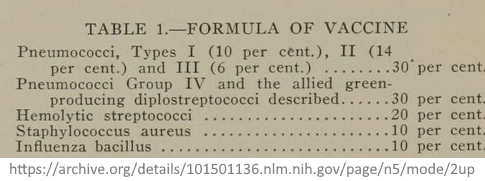
December 12, 1918 – Evening Times-Republican (Iowa) – Medical Men Map Plans to Combat “Flu” – Vaccination and Masks Endorsed – READ (How convalescent serum (plasma) is made)
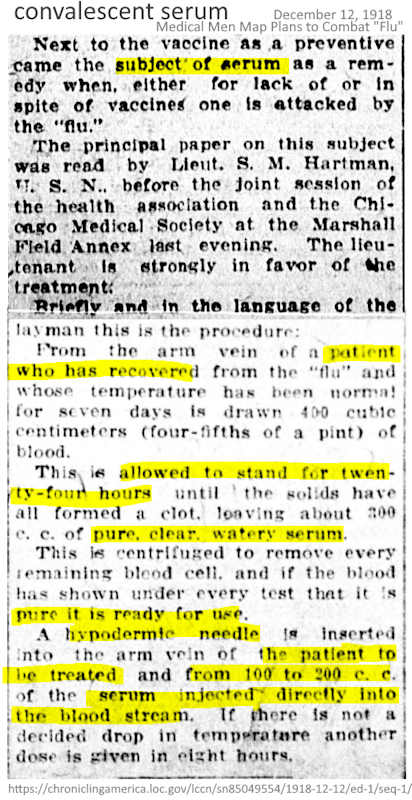
- American Public Health Association meeting formulates a NATIONAL program for health officers in fighting influenza epidemics.
- Not all health officers attending the meeting favoured face masks or vaccination – but among the likely measures to receive “official approval”. Widely divergent views, difference of opinions expressed regarding preventative measures, particularly officers in large cities vs rural areas.
- Dr W.H. Park of the committee on vaccines – “the disease was due to an ‘undetermined organism’, and the dominating variety of organisms differs according to various localities. Against use of “stock vaccine”. “He admitted that the most generally used form of vaccine [which??] offered some protection against the secondary or more serious stages of influenza, but little against the mild form of the disease and added that the vaccine generally had not been used until the peak of the disease, thus proving little”
- The “triple lipovaccine is now the official vaccine of the United States army” [Not sure what this is?]
- Next to the vaccine as a preventative came the subject of serum as a remedy when, either for lack of or in spite of vaccines one is attacked by the ‘flu’. Principal paper on this subject read by Lieut. S. M. Hartman US Navy. Serum = convalescent serum. Production procedure described for the layperson.
- Within a month (Jan 6, 2019) the serum, the “new remedy against influenza”, is promoted by – Dr Leary “get inoculated”, “use of serum will help stop influenza”..”it appears to be highly beneficial” -“I urge the public to find an opportunity and get inoculated” READ
December 16, 1918 – Webster City freeman, Iowa news – Free Vaccine to All People – READ Daily Gate City – READ, read more – HERE, Dec 28, 1918 last day of vaccination station – READ
- Remember “influenza” at this time was considered to be caused by Pfeiffer bacillus! Yet the article claims:
- “Physicians state that the use of pneumonia and influenza vaccine renders the patient immune from taking the disease”
- “No cure has yet been found applicable to all cases but the medical profession generally have full faith in the use of vaccine, which is newly discovered so far as concerns the Spanish influenza” [Yet the homeopaths were successfully curing and preventing pneumonia]
- The public as young as two years old volunteered their arms – READ , given by hypodermic needle – READ
- December 4, 1918 – The Daily Gate City news – Vaccination Station Here – opening soon – READ, 1,728 jabs by Dec 17, 1918, 81 of 98 appeared for their second shot – READ
- Pneumonia vaccine was discovered “several months ago” by E. C. Rasenow of Mayo laboratories. The vaccine is supplied free as long as the Board of Public Health stay in control and strict records of use are kept. “Its efficiency as a preventive is not known with the certainty…no flat statement can be made about it…It has only been used in a few hundred thousand cases…” – Daily Gate
December 27, 1918 – Public Health Reports Vol 33 No. 52: EPIDEMICINFLUENZA PREVALENCE IN THE UNITED STATES – PRELIMINARY STATISTICS OF THE INFLUENZA EPIDEMIC by Edgar Sydenstricker, Public Health Statistician, US PHS – READ
- The epidemic and its intermediate after effects are not vet ended.
- “…in practically no State or localitv had influenza been a reportable disease prior to the 1918 epidemic, and that in perhaps a very large proportion of localities it was not made a reportable disease until the epidemic was well under way.
December 28, 1918 – The Lancet Vol 195, Iss 4974: Some Observations on the Bacteriology and Pathology of “Influenza”, Delivered at the Royal Society of Medicine Nov 13, 1918 – Whittingham & Sims – READ
- “The following investigations were undertaken to ascertain whether the present October “influenzal” epidemic and the July “Spanish plague” were due to one and the same micro-organism or group of organisms.”
- Includes charts and post-mortem findings
- VACCINE TREATMENT.” The vaccine prepared by us was made from micro-organisms isolated from severe cases in the present epidemic. Most of the streptococci and pneumococci were obtained from postmortem examinations. The vaccine was used (1) as a prophylactic and (2) as .a curative….” – READ
- The War Office conference Oct 28, 1918 “recommended that the vaccine for influenza should consist only of B. influenza, pneumococcus, and streptococcus” protective effect if >40 period available before infection! – REF
December 28, 1918 – The Lancet Vol 195, Iss 4974: The Use of Vaccines in Acute Influenza and Influenzal Broncho-Pneumonia – READ
December 28, 1918 – The Lancet Vol 195, Iss 4974: Some Observations on the Recent Influenza Epidemic At a Base Hospital in France – D.T. Harris – page 877 – READ
1919
1919 – Navy: Annual Report of the Secretary of the Navy, 1919 — Miscellaneous Reports – Influenza – ARCHIVES
1919 – Annual Reports of the Navy Department for the fiscal year 1919 – READ, READ2
January 4 1919 – JAMA Vol 72, Issue 1: Prophylactic Inoculation Against Respiratory Infections During the Present Pandemic of Influenza: Preliminary Report by Rosenaow E. C. – pg 31-34 –READ,
- “Influenza” vaccination targeted the bacteria that cause the complications, the “secondary infection”, which caused the deaths – pneumonia
- “Both local and general reactions are decidedly less than those following typoid vaccines. Exceptionally severe reactions occur showing unusual individual susceptibility. The severer reactions are prone to occur in persons who give a history of recent exposure to the disease, or who already have beginning symptoms of it [Pathogenic priming!]. In these persons, attacks may appear to be precipitated by the vaccination; but the course if usually short and relatively mild.”…
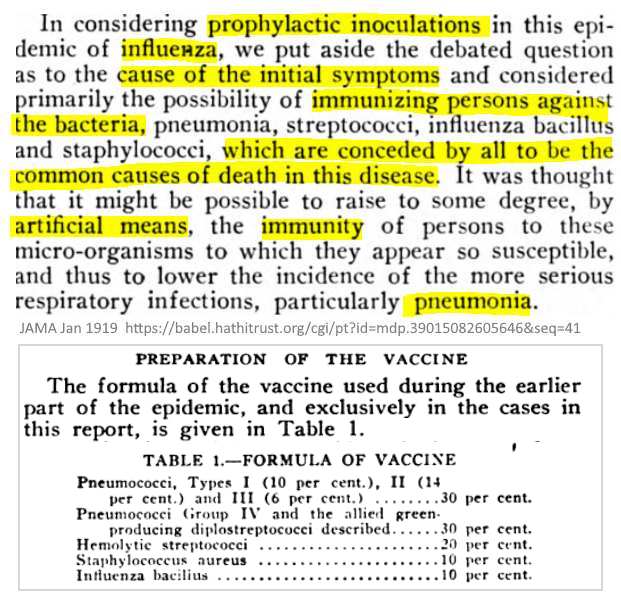
- References to random vaccines made during 1918 for “influenza”: JAMA page 44 – READ, Ref to Cutter Laboratory – READ, JAMA pg 1874 – READ
January 4 1919 – JAMA Vol 72, Issue 1: Treatment of Influenzal Pneumonia with Plasma of Convalescent Patients – O’Malley & Hartman (Navy) pg 34 – READ
January 6, 1919 – Boston Post: Inoculate Now, Urges Dr. Leary – READ [serum is not a vaccine so they say inoculated! It was only release last month!]
- Convalescent serum, the new remedy against influenza developed since the outbreak of the prevalent epidemic, is an immediately available safeguard against the disease…”I urge the public to find an opportunity and get inoculated”
February 1919 – Flu Pandemic.gov: Edward Gregory aged 24 was fed Asprin by the “½-hand full over and over again“, hours later he died – REF, CREDIT
In February 1919…Edward Gregory (age 24)…became ill with the flu…Edward′s fever kept getting higher and higher and the medicine of that day was aspirin, which was given to him by the ½-hand full over and over again. Edward sweated through his mattress and the local physician, Dr. Griffin, sat by his bed many hours but could not save his patient.
CDC web ARCHIVE
June 1919 – Archives Internal Medicine Vol 23, No 6: The Influenza Epidemic of 1918 in the American Expeditionary Forces in France and England, Archives Internal Medicine by MacNeal. W pg 657 – READ, referenced – HERE
- “Greater publicity was given to these reports in Spain, doubtless, in part, because that country was not engaged in war.” – This paper suggests pandemic “Influenza” originated in France
- “Until conclusive experiments have been carried out to decide the claims of the bacillus of Pfeiffer and of the filterable virus as the cause of influenza, one should keep an open mind in regard to the matter. It appears fruitless to attempt to settle the question by debate.”
July 12, 1919 – JAMA Vol 73, Issue 2: A METHOD FOR THE PREPARATION OF PROPHYLACTIC AND AUTOGENOUS LIPO-VACCINES by Rosenow et al from Mayo Foundation – READ, “Influenza vaccines” contained bacteria
July 19, 1919 – JAMA Vol 73, Issue 3: Survey of the Epidemic of Influenza in the American Expeditionary Forces by Warfield T. Longcope MD – READ
- “The origin of the epidemic of influenza and its invasion of Europe is still obscure; but it is certain that influenza existed in epidemic form in Spain, France and possibly England, early in 1918, and it may even have been present in endemic form during the previous year. By May, 1918, there was in Spain a widespread epidemic which received much publicity…”
August 2, 1919 – JAMA Vol 73, Issue 5: Experiments to Determine Mode of Spread of Influenza by MILTON J. ROSENAU, M.D. pg 311 – READ, PDF, CREDIT, JAMA start Issue No. 5 – HERE
- Experiments failed to reproduce the “influenza” disease with these experiments:
- Experiment where “pure culture” of Pfeiffer’s bacillus, though to be the causal agent of “influenza” was sprayed into the nasal passage of 100 healthy naval “volunteers” – “none of them took sick“
- Second experiment taking the mucus from sick patients, preparing that, sprayed into the nose and throat of healthy volunteers and “none of these took sick“.
- Even transfering mucus direct from patient to volunteer (2-3 times), none took sick!
- Drew blood from sick, prepared and injected into volunteers – “None of them took sick in any way“
- Simulated the “natural spread” between healthy volunteers coming into direct contact (talking, shaking hands, coughing) with sick “influenza” patients in hospital – “They were watched carefully for seven days—and none of them took sick in any way.”
- Similar experiment was done in Japan by Yamanouchi et al with cultured Pfeiffer’s bacillus and no symptoms were found, but they did produce disease using “An emulsion of the sputum from forty three influenza patients … made in Ringer’s solution” – READ
August 2 1919 – JAMA Vol 73, Issue 5: THE EPIDEMIOLOGY OF INFLUENZA by W. H. FROST, M.D., Surgeon, U. S. Public Health Service – READ
- Influenza epidemics: “even though a large proportion of the deaths are classified under diagnoses other than influenza” [Starting refine death count due to a disease labelled “influenza”!]
- Includes charts of 1889-1892 influenza epidemic.
August 2 1919 – JAMA Vol 73, Issue 5: BACTERIOLOGY OF RECENT PANDEMIC OF INFLUENZA AND COMPLICATING INFECTIONS by WILLIAM H. PARK, M.D., Director, Laboratories of New York City Health Department – READ
- “The pandemic of 1918 is over. The difficulty of being certain that any suspected cases are due to the pandemic virus is gradually increasing. It is probable that if we have not at the present time gathered sufficiently convincing evidence to convict some germ we shall have to wait for another epidemic to solve the problem”
August 2 1919 – JAMA Vol 73, Issue 5: THE SYMPTOMATOLOGY AND COMPLICATIONS OF INFLUENZA – READ
August 8, 1919 Public Health Reports | Vol. 34 No. 32: Influenza Studies: I. On Certain General Statistical Aspects of the 1918 Epidemic in American Cities by Raymond Pearl pg 1743-1783 –READ, CREDIT
- “It is certainly impossible now, and perhaps always will be, to make any precise statement,of the number of people who lost their lives because of this epidemic. But it is certain the total is an appalling one”
- “On the United States alone conservative estimates place the deaths from the influeinza epidemic at not less than 550,000, which is approximately five times the number (111,179) of American soldiers officially stated to have lost their lives from all causes in the war.”
- In the first place, owing to the advances which have been made in every branch of medical scienice since the epidemic of 1890, there is now available a much more adequate investigational armament with which to attack the problems raised by such an epidemic thani was the case earlier. Furthermore, the whole machinery for getting accurate records of the incidence and results of the outbreak are much better nlow than they were 30 years ago.”
- The records of mortality connected with the present epidemic are unquestionably more complete and accurate than any that have ever before been available in this country for any epidemic of anything like so great extent or force.”
- The present paper is initended as a first contribution toward the statistical analysis of certain phases of the 1918 influeniza epidemic…
- “On account of varying medical opinions as to the properly reportable terminal cause of death of persons dying after having had influenza during this epidemic, it has been thought safest to use death rates from all causes for study, rather than those specifically reported to the registrar as due to influenza or pneumonia. Consequently, we shall deal with death rates from all causes in discussing the present epidemic.”
- “There was an extraordinary degree of variation amongst the different cities in respect of the initial force and duration of this first explosion” Why?
- “The wave-like character of the curves in general is of great interest, The usual phenomenon was a large first wave followed by a series of other smaller…” but not always, thus “there must be discoverable clean-cut differentiating factors which influeinced the influenza death” between cities of different mortality curves
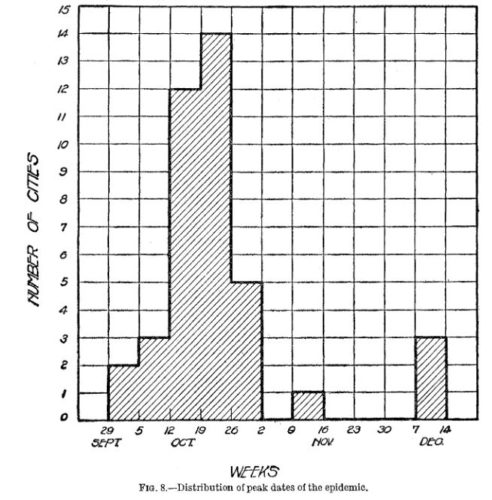
- “The existence of this high correlation at once indicates that an essential factor in determining the degree of explosiveness of the outbreak of epidemic influenza in a particular city was the normal mortiality conditions prevailing in that city..…those cities which had a relatively high normal death rate had also a relatively severe and explosive mortality from the influenza epidemic. …Similarly, cities which normnally have a low death rate had a relatively low, and not sharply expAosive, increase in mrortality during the epidemic.”
- “It will also be noted that the correlation in…those for pulmonary tuberculosis, so-called organic diseases of the heart, and chronic nephritis and Bright’s disease [kidney diseases], are of the same order of magnitude as that between the death rate from all causes and the explosiveness of epidemic outbreak of influenza”
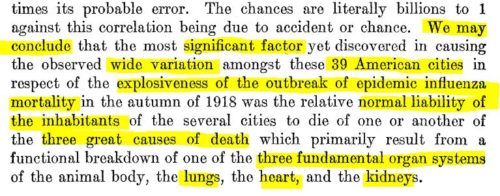
December 1919 – Journal of the American Medical Association Vol 73 – July-Dec 1919 – References to “influenza” – HERE (for you to explore)
1920
1920 – CDC: Department of Commerce United States of America: OFFICIAL Mortality Statistics 1918 – PDF, CDC – SOURCE
- Official mortality statistics for Influenza and pneumonia (all forms) in US (ex Hawaii) for 1918
- 477,467 total (583.2/100,000) compared to 125,795 (167/100,000) in 1917
- 79.8% mortality occurred Sept-Dec 1918 – equating to 381,018
- Highest rate from influenza and pneumonia since 1910. In 1918 deaths from other respiratory diseases “were comparatively few”! [Exactly like in 2020!]
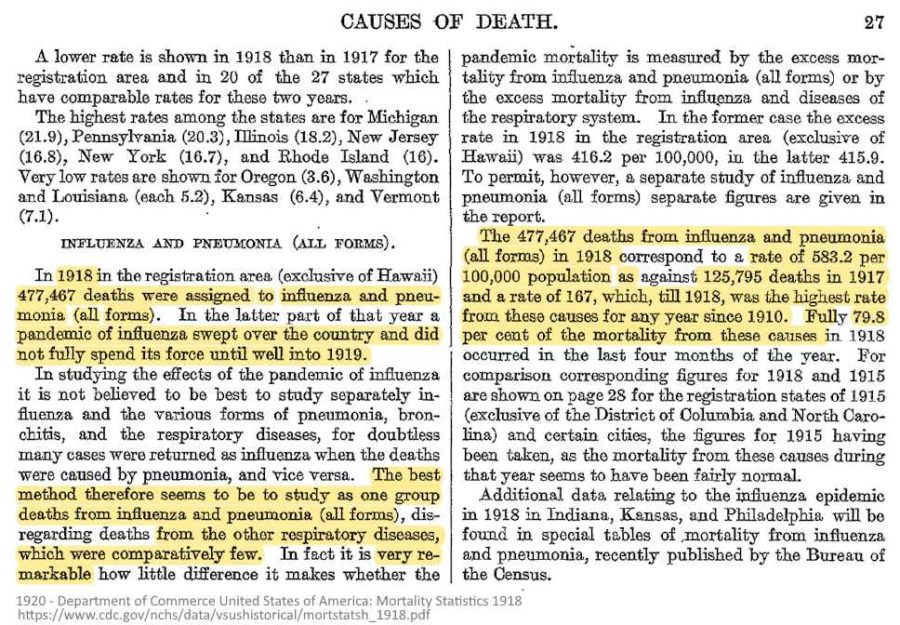
1920 – CDC: US Mortality – Special Tables of Mortality from Influenza and Pneumonia. Indiana, Kansas, and Philadelphia, PA. September 1 to December 31, 1918 – Breakdown by age and gender – PDF, SOURCE
- Distinct “W” shaped age mortality graphs “never seen before or after” this time period. Normally they are “U” shaped with highest mortality in the young and elderly – REF [I won’t why they only selected those 3 states?]

1920 – CDC: “No one knows exactly how many people died during the 1918-1919 influenza pandemic. During the 1920s, researchers estimated that 21.5 million people died as a result of the 1918-1919 pandemic. More recent estimates have estimated global mortality from the 1918-1919 pandemic at anywhere between 30 and 50 million. An estimated 675,000 Americans were among the dead.” – REF
- PHS officers surveyed after the pandemic “admitted that the data which was collected was probably inaccurate” “PHS scientists continued to search for the causative agent of influenza in their laboratories as did their fellow scientists in and outside the United States”…the funds for “influenza” research dried up!
1921
1921 – CDC: Department of Commerce United States of America: OFFICIAL Mortality Statistics 1919 – PDF, CDC – SOURCE
- Official mortality statistics for Influenza and pneumonia (all forms) in US (ex Hawaii) for 1919:
- 189,326 deaths (222.4/100,000) from influenza and pneumonia (all forms) vs 479,038 death 2018 (588.7/100,000) [note they increased this from previous years reports]
- 83.2% mortality in 2019 occurred in first six months of the year (Jan-June inclusive)
- Thus this pandemic ran from September 1918 – June 1919 (10 months)
- Some US states experienced consistent greater toll than other states, with the highest at 9.2 deaths/1,000 (Pennsylvania) and the city of Pittsburg with 12.7 deaths/1,000. Lowest state was Michigan (4.5) and lowest city was Grand Rapids (2.8). Their mortality was consistent across the 10 month period

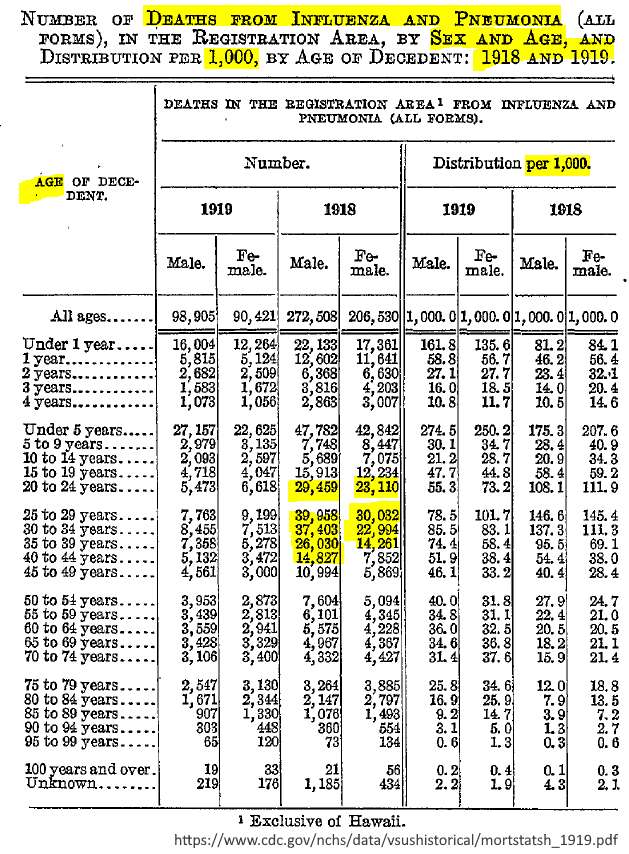
February 15, 1921 – The Homoeopathic Recorder Vol 36: Observations on the toxic action of Aspirin by Benjamin Woodbury – READ
- “This paper…merely represents some a posteriori deductions from the record of overdosage, thereby indicatingin a measure the toxic action of this universally used and abused drug.” Which was used 1918…
February 15, 1921- The Homoeopathic Recorder Vol 36: Vaccination and the Public Health by F. M. Padelford, M.D., pg 56 – READ (pls read in full)
- “The influenza outbreak of 1918 assumed alarming characteristics in the army camps. Whether the disease originated there or was introduced from the outside we do not know. But among the soldiers it spread rapidly. So great a degree of malignancy had it acquired when it reached the civil population, as it was bound to do ultimately, that only persons whose resistance was exceptionally high were able to resist it.
- “The bacteriology of the disease is even now largely a matter of speculation. Whether the worst cases owed their malignancy to secondary infection with some virulent strain of streptococci, we do not know, yet this appears to have been the case”
- “As is generally known, with few exceptions indeed, men entering the Service were compelled to submit to repeated injections of killed bacilli of typhoid and para-typhoid fevers, and in addition to this to inoculation with the non-sterilized bacterial compound, commonly known as ” vaccine lymph.” [toxic soup!]
- “In 1911 specimens of virus [common term for pathogen pus/toxin, not virus as we know today] propagated in the laboratories of two of the leading manufacturers of such products in the United States, were purchased in the open market and subjected to exhaustive bacteriological and biological tests. From these specimens twenty-two different microorganisms were isolated. Eighteen out of the twenty-two were found to be pathogenic; six were pyogenic or pus-producing; fourteen were mortal to laboratory animals. One, which resembled the bacillus of malignant oedema, caused the death of a guinea pig within thirty-six hours.”
- Were there fewer deaths in the world than there would have been, had the “immunizer’s” syringe and the vaccinator’s lancet not been used?”
February 15, 1921 – The Homoeopathic Recorder Vol 36 – Some interesting facts for the busy doctor pg 66- READ [Seems the skill of the allopathic doctor in 1918 was lacking!]
- “Our medical colleges are to blame for turning out students who can’t diagnose a case of cancer or treat it successfully by medicine. The medical students graduated from our medical colleges should be taught how to treat successfully any of the diseases common to our country. If they can’t do that, then of what earthly use are they?”…What do you really know about healing the sick? This is ” the supreme test,” the acid test, of a doctor’s skill….”
February 15, 1921 – The Homoeopathic Recorder Vol 36 – The value of definite therapeutics, By Eli G. Jones, M. D., pg 165 – READ
- “The allopath is governed by no law of Therapeutics. He simply prescribes a certain remedy or combination of remedies, because he has read somewhere or heard that it is “good for that disease”, he is apt to change his remedies every day or two for he is not sure of anything. In his mind there is always the element of uncertainty, he hopes for the best, but it is mostly guesswork and experimenting on his part.“
- “When the epidemic of influenza swept over this country in 1918 it found the regular schools unprepared to treat it, because they had not been taught how to cure it in their medical colleges. It has been the same with every epidemic that has visited this country, the regular doctors were unprepared, and as a result they went down to defeat, with a frightful mortality.”
- “We speak of the thousands of brave men who sacrificed their lives on the soil of France in the cause of human liberty, but what of the 500,000 victims who died from influenza in 1918, have you forgotten them, and that the great majority of them were treated by regular physicians! It has given that school of medicine a ”black eye” from which they will never recover. It has become a part of medical history, as the record is made so it must stand!” [it seems we have ‘forgotten’]
- “The Eclectics and the Homoeopaths had been taught in their medical colleges how to treat influenza successfully, so that when the epidemic came in 1918, it found them PREPARED to treat it and cure it, with a mortality of less than one per cent.!” [Less than 1% mortality!] – REF
- “To make the blow still worse for the regular school that the Drugless Healers during the epidemic of influenza in 1918, throughout the country (without giving any medicine at all) reported a mortality of less than one per cent“.
February 15, 1921 – The Homoeopathic Recorder Vol 36: “THE ELECTRONIC REACTIONS OF ABRAMS.” pg 198 – READ
- Paul Ehrlich, German biochemist developed Salvarsan or compound 606, a arsenic-based drug to treat syphilis in 1909. 2 million tubes of Salvarsan was made under government licence during the war, earning the makers $500K! Neosalvarsan was given by injection, one patient was give 34 injections, apparently not uncommon. “The Wassermann Laboratories must have been working “overtime,” as the surgeons had found so many infected with the disease.” The govt seemed to pay no attention to it’s uselessness as a treament. – REF
- “Were soldiers drugged with arsenic as well during the 1918 panemic? As venerial disease was rife.”Medical Department of the United States Navy, which had had such poor results with the use of this preparation, that they were considering its discontinuance.” [After treating how many soldiers in 1918 with toxic subtance??]
May 1921 – J. Am. Inst. Homeopathy: Homeopathy in Influenza: A Chorus of Fifty in Harmony by W.A. Dewey – PDF
- 50 quotes of succusses with homeopathic treatment during 1918 pandemic – very few died under treatment of a homeopath
- Aspirin directly or indirectly caused more loss – taken in massive doses until prostration which led to development of pneumonia
- 30% mortality with old school, 1.05% mortality with homeopathy
1922
January 20, 1922 – The American Journal of Hygiene (Johns Hopkins Univesity publication) | Vol II 1922: NOTE ON CERTAIN CORRELATION FACTORS OF THE 1918 INFLUENZA EPIDEMIC by Winslow & Grove Pg 240 – READ
- “In his first statistical study of the 1918 epidemic of influenza, Raymond Pearl (1) showed that the explosiveness of the outbreak in a group of the larger American cities was strikingly correlated with the normal death rate from all causes in those cities during the year 1916, and particularly with the death rates from pulmonary tuberculosis, diseases of the heart and diseases of the kidneys”
- “Pearl’s discovery of the relation which the explosiveness of the epidemic bore to the normal death rate from all causes and from organic heart disease in the affected communities remains perhaps the most outstanding discovery which has been made in the study of this disease since the recent outbreak.”
- (1) August 8, 1919 Public Health Reports | Vol. 34 No. 32: Influenza Studies: I. On Certain General Statistical Aspects of the 1918 Epidemic in American Cities by Raymond Pearl pg 1743-1783 –READ, CREDIT
1923
December, 1923 – American Journal of Public Health: RECIPROCITY BETWEEN THE HEALTH OFFICIALS AND THE MEDICAL PROFESSION by Dr. E. C. Levy, Director of Public Welfare – READ, PDF, CREDIT
- “In explanation of why these quacks and cults were consulted,…[From a public survey] “nearly all of them show profound ignorance of just what constitutes the difference between the regular practitioner of medicine and the quack.” [maybe it has to to with the health outcomes!]
“In spite of the fact that regular medical practice to-day is incomparably superior to what it has ever been, nevertheless there has never been a time when the people had less confidence in it.”
“It is as much the duty of the health officer as it is to the interest of the doctors to combat this tendency on the part of the people to seek the aid of practitioners of all manner of ” pathies ” and ” isms.”,,,The health officer can preach the inadequacy and the danger of these cults and not have selfish interest charged against him.
If the word of the health officer is to be accepted by the public he must himself have their confidence, and no agency can so build up confidence in the health officer as can the medical profession. [You scratch my back, I’ll scratch yours]
Dr. E. C. Levy, Director of Public Welfare
November 1923 – The Society of Friends of Medical Progress – A National Lay Society – organised and incorporated in 1923: Why it was founded? – READ , CREDIT in time this organisation becomes The American Association for Medical Progress – New York times “..to Offset Propaganda Dangerous to Public Health” – READ
- The society was set up to counter the efforts of “the anti-vaccinists and anti-vivisectionists in resisting the attacks of organized and compulsory State Medicine on the rights of the individual and the compassionate claims of dumb animals.” – REF
- [Kind of sounds familiar – Fast forward 100 years! – Friend of Science in Medicine Australia – a lobby group that took down naturopathy and homeopathy – READ]
April 1923 – Hygeia: a monthly magazine by the American Medical Association was first published – ARCHIVE, Volume 1 ARCHIVE, CREDIT Editor Dr. Morris Fishbein head of AMA
- What is a Chromosome? by Julian Huxley pg 30 – READ
- Louis Pasteur and His Work pg 32 – READ
- Patent Medicines and why pg 43 – READ

1924
November 19, 1924 – Medical Journal and Record, New York – Editorial Articles: Whither are we tending? – READ, CREDIT
The doctor himself has in a measure forsaken the art of medicine for the science of medicine, perhaps for the business of medicine; frequently, the sick man ceases to be a patient and becomes a case, a vehicle for an interesting disease.
The public, …is growing restive under the high cost of medical and surgical treatment and is seeking relief in the realm of quackery, isms and pathies. … the public is ”getting doctor shy”.
1925
July 1925 – Scientific Monthly: The Future Progress of Medicine by Dr Alexis Carrel of the Rockefeller Institute – READ, CREDIT
To-day, medicine consists of an immense quantity of observations, partly empirical and partly classified according to scientific method. It is a science in the making.
…It is clear that the future progress of medicine must consist in finding the nature and causation of some of these diseases and their prevention.
Dr Alexis Carrel
July 7, 1925 – “The Medical Follies” by Morris Fishbein M.D. Editor of the Journal of the American Medical Association – ARCHIVE, PDF – An attack against “The Cults”, quacks and any other competition to “scientific medicine”
- [Be sure to read the counter argument “These Cults” (below) by independent journalist Annie Riley Hale published 1926]

1926
1926 – “These Cults” by Annie Riley Hale [independent journalist]- “An Answer to Dr Morris Fishbein’s venomous “The Medical Follies” [Published 2025] with iconoclastic chapters on Homeopathy, Osteopathy, Chiropractic, The Abrams Method, Vivisection, Physical Culture, Christian Science, etc.” – ARCHIVE, PDF
- “An Answer to Dr Morris Fishbein‘s venomous “The Medical Follies” with iconoclastic chapters on Homeopathy, Osteopathy, Chiropractic, The Abrams Method, Vivisection, Physical Culture, Christian Science, etc.”
- “These Cults” is an emphatic protest against State Medicine and if it shall serve no other purpose than to arouse in its readers the average person’s love of fair play, it will not have been written in vain.”
- This book These Cults contains some statistics garnered from that time.
“After reading “THESE CULTS” I can understand why the big pulishers were afraid to touch it. …It is a powerful indictment of the follies of Medicine and by all odds the best and most readable book on the subject printed in the English language”
Alexander Marky [from front cover]
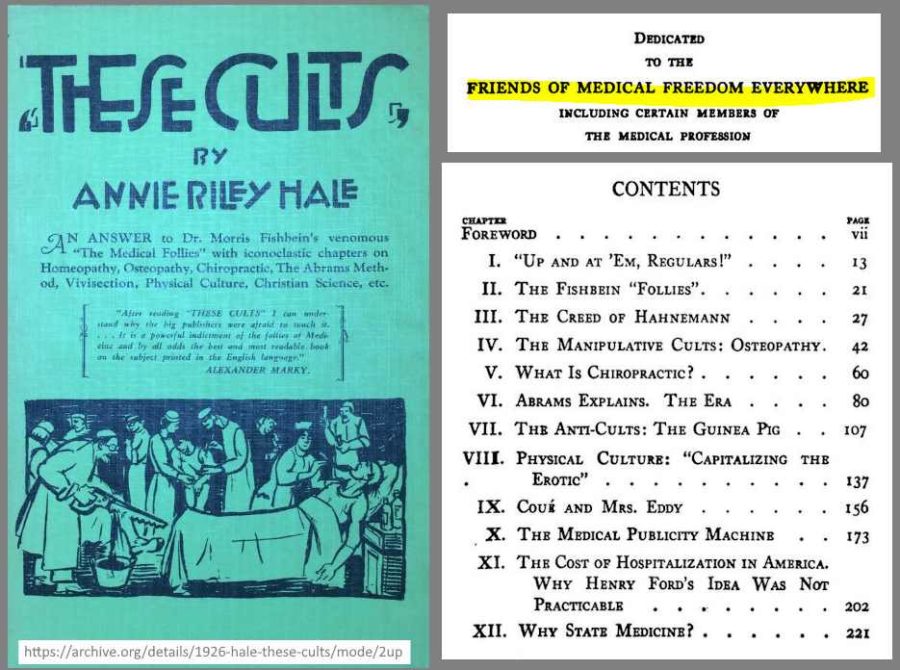
Excerpts from this book regarding fatalities during the 1918 “flu” :
- Osteopaths: 6-7% – REF
- “The mortality percentage under osteopathic treatment was obtained from report blanks furnished all practicing osteopaths in the United States and Canada for data on all cases of influenza and pneumonia.”
- Chiropractic – REF
- “The Chiropractic figures in the 1918 “Flu” epidemic showed a loss of one patient in 789, whereas the M.D.’s lost one in 16.”
1933
1933 – CDC: “It was not until 1933 that the influenza A virus, which causes almost every type of endemic and pandemic influenza, was isolated. Seven years later, in 1940, the influenza B virus was isolated. The influenza C virus was finally isolated in 1950.”… Influenza vaccine was first introduced as a licensed product in the United States in 1944″ – REF
1944
1944 – CDC: “Influenza vaccine was first introduced as a licensed product in the United States in 1944. Because of the rapid rate of mutation of the influenza virus, the effectiveness of a given vaccine usually lasts for only a year or two.” – REF
1986
1986 – FDA issued a warning statement on all over the counter (OTC) drugs containing aspirin, which was updated in 1993 – (pg 5) REF Aspirin-associated Reye’s syndrome, a abrupt, profound failure of mitochondria typically preceded by a viral infection [now think 1918!]
- 1986: “Children and teenagers who have or are recovering from chicken pox, flu symptoms or flu should NOT use this product”
- 1993: “Children and teenagers who have or are recovering from chicken pox, flu symptoms or flu should NOT use this product. If nausea, vomiting, or fever occur, consult a doctor because these symptoms could be an early sign of Reye’s Syndrome, a rare but serious illness.”
- 2004 (Australian label): “Consult a doctor before giving this medicine to children or teenagers with chicken pox, influenza or fever” (pg 4)
1997
March 21, 1997 – Science: Initial genetic characterization of the 1918 “Spanish” influenza virus by Taubenberger et al – READ, READ2
- (At this time Taubenberger worked for the Armed Forces Institute of Pathology, Washington DC, he would later go on to work under Dr Anthony Fauci at the NIAID)
- “The “Spanish” influenza pandemic killed at least 20 million people in 1918-1919″ – note this gets raised to 50 million in a few years! The case mortality rates are estimated “over 2.5%”, and most deaths amongst the young aged groups.
- The sample was “isolated from a formalin-fixed, paraffin-embedded, lung tissue sample”…”The sequences are consistent with a novel H1N1 influenza A virus that belongs to the subgroup of strains that infect humans and swine, not the avian subgroup.” “The group has analyzed only about 7 percent of the virus”
- “The first human influenza virusus were not isolated until the early 1930s… characterization of the 1918 strain has had to rely on indirect evidence”
March 21, 1997 – The New York Times: Genetic Material of Virus From 1918 Flu Is Found – PAGE1, PAGE2
- “Of the 198 cases that Dr. Taubenberger requested, 7 met his criteria. But only one had other features that led the researchers to believe that the flu virus was actively replicating when the man died.”
- “The researchers spent nearly two years amplifying the tiny segments of viral RNA so that they would have enough to analyze and assemble like a jigsaw puzzle.”…”they report on the sequences of nine fragments of the virus that include pieces of its major genes” [They didn’t get the entire sequence!]- PAPER
- The soldier’s sample chosen was from “Fort Jackson” – which according to the archived Surgeon General’s report ther is no mention of “Fort” only Camp Jackson.
- The soldier “was a healthy 21-year-old male with no medical history” from New York and “died within five days of infection, on Sept. 26, 1918, and in October his lung tissue was shipped to Washington, where it was stored, undisturbed, for nearly 80 years.” – curiously another paper stated he died “6 days after appearance of symptoms” [Same author!]
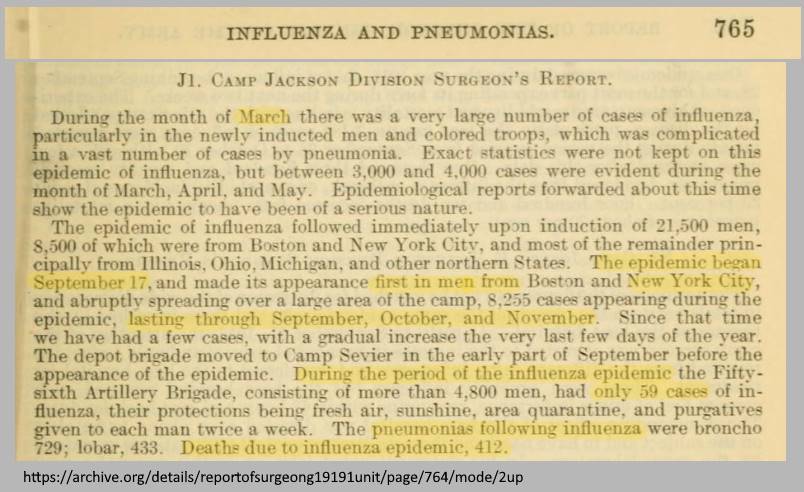
April 7, 1997 – NIAID Statement | Director Anthony S. Fauci, M.D. – World Health Day – Emerging Infectious Diseases – Global Alert, Global Response – ARCHIVE
- [The Theme] reflects our heightened awareness that our battle with infectious diseases is far from over and must be fought on many fronts.” [War terminology!]
- “Many people do not realize that infectious diseases remain the leading cause of death worldwide, and the third leading killer of Americans. Adding to the problem is the development of drug resistance…”
- “My 86-year-old father… As a young boy he saw many relatives and acquaintances succumb to influenza during the great flu pandemic of 1918, which claimed at least 20 million lives worldwide.” [preparing for more than 20 million!]
- NIAID has developed a comprehensive Research Agenda for Emerging Infectious Diseases [READ], – Goals include vaccine development – READ
August 1997 – Brevig Mission, Alaska – four permafrosted bodies were exhumed from mass graves, throught to have died in 1918 influenza pandemic – REF
- “One of the victims, an Inuit female (age unknown) was influenza RNA positive [A/Brevig Mission/1/18 (H1N1)]. In this case, RNA templates greater than 120 nucleotides could not be amplified.”
1998
February 8, 1998 – NY Times: Alaskan Victim of 1918 Flu Yields Sample of Killer Virus – READ
- Dr. Jeffery K. Taubenberger of the Armed Forces Institute of Pathology – “biopsy samples from a corpse exhumed from a cemetery in Brevig Mission, Alaska, contained genetic material from the flu.”
- “Last year, Army researchers identified the flu virus in preserved lung specimens taken during autopsies of soldiers killed by the flu in 1918 at military bases in Fort Jackson, S.C., and Camp Upton, N.Y.”
- “Dr. Johan Hultin, a retired San Francisco pathologist, exhumed four bodies from a mass grave and found that one, an obese woman, had been well-preserved. Tissue from her lung contained genes [ASSUMED TO BE] from the killer flu.”
- “In a mass grave in a remote Inuit village near the town of Brevig Mission, a large Inuit woman lay buried under more than six feet of ice and dirt for more than 75 years. The permafrost plus the woman’s ample fat stores kept the virus in her lungs so well preserved that when a team of scientists exhumed her body in the late 1990s, they could recover enough viral RNA to sequence the 1918 strain in its entirety.” – REF
1999
February 16, 1999 – PNAS: Origin and evolution of the 1918 “Spanish” influenza virus hemagglutinin gene – Reid et al (incl Taubenberger, all with the Armed Forces Institute) – READ
- “These samples were from patients who experienced acute influenza deaths after clinical courses of less than 1 week….Of these 13 samples, [Only] 2 were positive for influenza RNA on subsequent molecular genetic analysis.”
- “Here, we report the complete sequence of the hemagglutinin (HA) gene of the 1918 virus.” as constructed from 2 cases – “Fort Jackson”21-year-old male stationed at Ft. Jackson, SC” who died September 26, 1918 [A/South Carolina/1/18 (H1N1)]
- “The second patient was a 30-year-old male stationed at Camp Upton, NY. He was admitted to the camp hospital with influenza on September 23, 1918, had a very rapid clinical course, and died from acute respiratory failure on September 26, 1918” [A/New York/1/18 (H1N1)]
- “An additional 1918 influenza case was found by examining lung tissue from four 1918 influenza victims exhumed from a mass grave in Brevig Mission on the Seward Peninsula of Alaska. Brevig Mission (called Teller Mission in 1918) suffered extremely high mortality during the influenza pandemic in November 1918…Although individual case records were not available, historical records show that influenza spread through the village in about 5 days, killing 72 people, representing about 85% of the adult population” [So it is assumed this exhumed person had “influenza”]
- In August 1997, four of these victims were exhumed.
April 1999 – WHO: Influenza Pandemic Preparedness Plan. The Role of WHO and Guidelines for National and Regional Planning – ARCHIVE, Introduction – READ
- “The pandemic of 1918/19 was the most severe [influenza pandemic]; an estimated 20 million people died worldwide”
April 1999 – WHO – Influenza Pandemic Plan. The Role of WHO and Guidelines for National and Regional Planning – PDF, SOURCE (by 2005 the WHO estimated a flat 40 million, and by 2009 20-50 million.)
- “In 1918-20, a pandemic occurred that is renowned for its severity, being held responsible for 20 to 40 million deaths in the world (Ghendon, 1994; Marwick, 1996). The overall clinical attack rate was as high as 40%, and severe forms of pneumonia were common. It seems highly likely, based on observations in subsequent pandemics, that the actual infection rate was even higher. Particularly noteworthy was that the attack rate and mortality were generally highest in 20-50 year old adults (de Gooier, 1978). At the time, laboratory methods did not exist to identify the causative agent. Convincing data, obtained later, however, showed that the pandemic was caused by a type A(H1N1) influenza virus closely related to viruses that can be still be found in pigs in some countries (Taubenberger, 1997).” – hence Swine flu.
2000
May 23, 2000 – PNAS: Characterization of the 1918 “Spanish” influenza virus neuraminidase gene – by Reid, Fanning, Janczewski and Taubenberger (all from Armed Forces Institute of Pathology) – READ
2003
September 1, 2003 – Journal of General Virology: The origin of the 1918 pandemic influenza virus: a continuing enigma – Reid & Taubenberger (Armed Forces Instituted of Pathology) – READ
- The 1918 pandemic killed nearly 700 000 Americans and 40 million people worldwide” [that estimate has doubled since previous publications, in 1997 it was 20 million from same author!, CDC now like 50 million!]
- The figure quoted of “30,000” die each year from influenza in US is based on alleged estimates here Simonsen et al. 2000; and here Thompson et al. 2003 – REF) [Lets throw darts!]
2004
January 2004 – Australian Dept Health & Ageing: Protecting Australia against Communicable Disease: Everybody’s Business – PDF Doc refrenced by Aust Jane Halton – HERE
- “The devastating Spanish Influenza of 1918-1919 caused at least 20 million deaths worldwide. Australian troops in France during the First World War were also severely affected by influenza in October 1918″ 12,000 Australian deaths of a population of 5 million, over half young adults
- The Australian Director of Quarantine decided to exclude the disease by quarantining 174 ‘infected vessels’. Although influenza broke out in some ships detained in quarantine, there was no escape of the infection on the mainland.
- When influenza did occur in Melbourne in January 1919, it was milder than the disease experienced elsewhere in the world possibly because, over time, patients with severe symptoms were more effectively isolated.”
2004 – WHO Guidelines on the Use of Vaccines and Antivirals during Influenza Pandemics REPORT- makes this statement about 1918 pandemic: – PDF, SOURCE
- “The H1N1 pandemic of 1918-1919 was the most devastating in history with a total mortality of 40–50 million. In the United States, it killed 550,000 people, representing approximately 0.5% of the population. In Scotland, 1 in 200 to 1 in 300 of the population died. In England and Wales there were 200,000 deaths, and by December 1918, an estimated 4.9 million excess deaths (about 2% of the whole population) occurred in British India, the vast majority occurring within the space of two months.”
~Aug 2004 – CDC – Influenza Pandemics – ARCHIVE, Aug 2004 – ARCHIVE
- “An influenza pandemic is a global outbreak of disease that occurs when a new influenza A virus appears or “emerges” in the human population, causes serious illness, and then spreads easily from person to person worldwide.”
2004 – “CDC studies of the 1918 influenza virus were begun in 2004 with the initiation of testing of viruses containing subsets of the eight genes of the 1918 virus.” – REF, CDC biolab safety BSL-3 – ARCHIVE
2005
September 30, 2005 – The Intra-governmental Select Agents and Toxins Technical Advisory Committee convened on September 30, 2005, and recommended that the reconstructed 1918 influenza virus be added to the list of HHS select agents. – REF,
- HHS Select Agenst list: “Reconstructed replication competent forms of the 1918 pandemic influenza virus containing any portion of the coding regions of all eight gene segments (Reconstructed 1918 Influenza virus)” – WEB
- October 20, 2005: National Select Agent Registry: Addition of Reconstructed 1918 Influenza virus to the list of HHS select agents and toxin – ARCHIVE, SOURCE, Federal Register – PDF which “killed up to 50 million people worldwide”
- “…the complete coding sequence for the 1918 pandemic influenza A H1N1 virus was recently identified, which will make it possible for those with knowledge of reverse genetics to reconstruct this virus”
- “In addition, the first published study on a reconstructed 1918 pandemic influenza virus demonstrated the high virulence of this virus in cell culture, embryonated eggs, and in mice relative to other human influenza viruses. Therefore, we have determined that the reconstructed replication competent forms of the 1918 pandemic influenza virus containing any portion of the coding regions of all eight gene segments have the potential to pose a severe threat to public health and safety.” – PDF
October 5, 2005 – NIAID STATEMENT- Unmasking the 1918 Influenza Virus: An Important Step Toward Pandemic Influenza Preparedness – joint statement by Anthony S. Fauci, M.D (Dir NIAID) & Julie L. Gerberding (Dir. CDC) – ARCHIVE
October 5, 2005 – Mount Sinai School of Medicine Press Release: Reconstructed 1918 Flu Virus Providing Insights for Potental Pandemics – Technique Developed and Patented by Mount Sinai School of Medicine Researchers Used to Reconstruct 1918 Virus – ARCHIVE
- “For the first time, this deadly 1918 Spanish flu virus has been reconstructed and characterized.”
The reconstructed virus is contained at the CDC, following stringent safety conditions designated for flu viruses and other “select agents.” - “The virus was reconstructed using reverse genetics, a technique Drs. Garcia-Sastre and Palese developed.”
- “The emergence of another pandemic is considered highly likely by many experts, but it is currently not possible to predict which viruses will become pandemics or how virulent a pandemic virus will be.”
- “Mounts Sinai School of Medicine researchers received U.S. patent number 6,544,785 for a technique they developed to create viruses from DNA. The technique, known as reverse genetics or Plasmid Rescue Technology, is specifically designed to work with viruses that use RNA for storing their genetic material. Influenza is one such virus.”
- Without reverse genetics, vaccine development is somewhat of a hit or miss procedure….Reverse genetics circumvents this usual procedure. Researchers can custom build a virus to meet their needs. The method is faster and also provides a means for researchers to alter the virus to have markers that allow safer handling and to eliminate pathogenic markers to enhance the safety of the vaccine. Custom building viruses for vaccines also facilitates greater quality control by reducing genetic variation in production.”
October 5, 2005: CDC Press Release: Researchers Reconstruct 1918 Pandemic Influenza Virus; Effort Designed to Advance Preparedness – CDC Director Dr. Julie Gerberding – ARCHIVE, CDC web page – ARCHIVE, CREDIT
- “Scientists at the Centers for Disease Control and Prevention have successfully reconstructed the influenza virus strain responsible for the 1918 pandemic, a project that greatly advances preparedness efforts for the next pandemic.”
- “Research such as this helps us understand what makes some influenza viruses more harmful than others. It also provides us information that may help us identify, early on, influenza viruses that could cause a pandemic.”
- “The work, done in collaboration with [CDC], Mount Sinai School of Medicine [PRESS], the Armed Forces Institute of Pathology and Southeast Poultry Research Laboratory, determined the set of genes in the 1918 virus that made it so harmful. Prior to this study…flu experts had little knowledge of what made the 1918 pandemic so much more deadly than the 1957 and 1968 pandemics.”
- “The 1918 pandemic killed an estimated 20-50 million people worldwide, including 675,000 in the United States. The pandemic’s most striking feature was its unusually high death rate among otherwise healthy people aged 15-34….Most experts believe another pandemic will occur…”
- “By identifying the characteristics that made the 1918 influenza virus so harmful, we have information that will help us develop new vaccines and treatments,” said Dr. Terrence Tumpey, the CDC senior microbiologist who recreated the virus.”
- “In reconstructing the 1918 influenza virus, researchers learned which genes were responsible for making the virus so harmful. This is an important advance for preparedness efforts because knowing which genes are responsible for causing severe illness helps scientists develop new drugs and vaccines (e.g., they can focus their research on those genes).
- All laboratory work was conducted at CDC. The work was supported in part with funding from the U.S. Department of Agriculture and the National Institutes of Health. …To evaluate the benefits of publishing the information contained in these manuscripts and any potential threat from its possible deliberate misuse, both manuscripts were reviewed by the National Science Advisory Board on Biosecurity (NSABB).
October 7, 2005 – Science: Characterization of the Reconstructed 1918 Spanish Influenza Pandemic Virus by Tumpey, Taubenberger et al – READ
Three major discoveries about the virulence of the 1918 virus are included in the Science report: –REF
- 1) It is extremely virulent in mice, leading to rapid death.
- 2) It is pathogenic in embryonated chicken eggs
- 3) It grows very rapidly in human lung cells
October 6, 2005 – Nature: Characterization of the 1918 influenza virus polymerase genes – Jeffery Taubenberger et al – READ, National Geographic – CREDIT
- Claim to have found the RNA virus (after 75 years) that caused 1918 influenza – isolated from frozen 1918 human lung tissue
- “This study was partially supported by a grant to J.K.T. from National Institutes of Health (NIH), and by intramural funds from the Armed Forces Institute of Pathology.”…”The opinions contained herein are the private views of the authors…”
- “When the complete sequence of the 1918 virus was published in 2005, it represented a watershed event for influenza researchers worldwide. – REF
October 2005 – Armed Forces Institute of Pathology (AFIP) Letter Vol 163, No 3 Fall 2005: Breaking the genetic code: AFIP’s Taubenberger unlocks mystery to 1918 Spanish flu – Findings play major role in H5N1 pandemic preparations – PDF, AFP – SOURCE
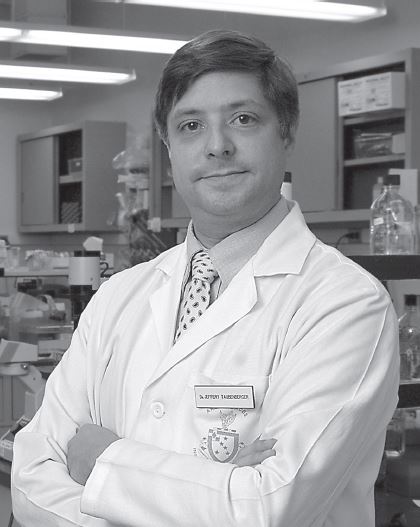
- “Their findings…come as world leaders press for extraordinary measures to prevent a new pandemic that could” occur if the currently circulating H5N1 bird influenza becomes able to spread among humans. The AFIP team previously published the sequences of 5 of the 1918 virus’s 8 gene segments. In their latest paper, Taubenberger and his colleagues report the remaining 3 gene segments, the so-called polymerase genes, which allow the virus to replicate in host cells…”
2005 – WHO – WHO global influenza preparedness plan – The role of WHO and recommendations for national measures before and during pandemics (2005)- PDF
- The pandemic of 1918 is estimated to have killed more than 40 million people in less than one year, with peak mortality rates occurring in people aged 20–45 years.
2006
March 2006 – Proc Am. Philos. Soc. – The Origin and Virulence of the 1918 “Spanish” Influenza Virus by Taubenberger – READ
- “In the United States, influenza is estimated to kill 30,000 people in an average year (Simonsen et al. 2000; Thompson et al. 2003).”
March 6, 2006 – UNC Chapel Hill | Press Relese: Aspirin is cost-effective at preventing heart disease in more men than previously thought, study shows – ARCHIVE
- The study also showed that aspirin was not effective for men whose 10-year risk was below 5%, because the chance of adverse effects from bleeding cancelled the benefit from prevention of coronary heart disease events. [Reports of bleeding in 1918]
January 2006 – CDC: 1918 Influenza: the Mother of All Pandemics by Taubenberger & Morens – READ
- “In 1995, a scientific team identified archival influenza autopsy materials collected in the autumn of 1918 and began the slow process of sequencing small viral RNA fragments to determine the genomic structure of the causative influenza virus – READ
- “The disease was exceptionally severe. Case-fatality rates (CFR) were >2.5%, compared to <0.1% in other influenza pandemics”
- “By the early 1990s, 75 years of research had failed to answer a most basic question about the 1918 pandemic: why was it so fatal?” [Indeed why!]
- Why Did the 1918 Virus Kill So Many Healthy Young Adults?
- The “age-specific death rates in the 1918 pandemic exhibited a distinct pattern that has not been documented before or since: a “W-shaped” curve,” – VIEW
- 1997 Science: Initial genetic characterization of the 1918 “Spanish” influenza virus by Taubenberger et al – READ (reference that it killed at least 20 million people)
2007
January 2007 – Antiviral Therapy Journal: Discovery and Characterization of the 1918 Pandemic Influenza Virus in Historical Context – by NIAID’s Jeffery K Taubenberger, Johan V Hultin, and David M Morens – READ
- “2005 completion of the entire genome sequence of the 1918 H1N1 pandemic influenza virus represents both a beginning and an end.”
July 2, 2007 – Eurak Alert PRESS RELEASE: Scientists describe how 1918 influenza virus sample was exhumed in Alaska – Finding critical to future pandemic planning – by NIAID – READ
July 4, 2007 – Science Daily: Scientists Describe How 1918 Influenza Virus Sample Was Exhumed In Alaska – READ
- “When the complete sequence of the 1918 virus was published in 2005, it represented a watershed event for influenza researchers worldwide.”
2008
August 19, 2008 – NIAID Press Release: Bacterial Pneumonia Caused Most Deaths in 1918 Influenza Pandemic – Implications for Future Pandemic Planning – READ
- “The NIAID press release did not, however, address what caused the bacterial infections, but research by Dr. Karen Starko does. She implicates aspirin, dovetailing with the NIAID research on pneumonia from massive bacterial infection, and goes further in also explaining the extreme rapidity of death…” – REF
August 19, 2008 – CIDRAP: Researchers find long-lived immunity to 1918 pandemic virus – READ, READ
- PBS News: 90 Years Later, 1918 Flu Lives on in Antibodies, Research – READ, National Geopgraphic – READ , CREDIT,
- Aug 17, 2008 – HHS Public Health Accesss: Neutralizing antibodies derived from the B cells of 1918 influenza pandemic survivors – Altschuler, Basler, Crowe et al – STUDY, Nature – ARCHIVE
- Blood samples from 32 New Jersey residents who were toddlers or young children in 1918 had antibody-producing B cells…
- In order to test whether the antibodies were still effective, researchers at the Centers for Disease Control injected the antibodies into mice, then exposed the mice to a reconstructed version of the 1918 flu strain (CDC scientists reconstructed the virus for research purposes in Oct 2005). The antibodies successfully protected the mice from the disease.
- Scientists have long wondered what made the 1918 flu so much more deadly than other flu strains? And common bacteria took advantage of the weakened lungs and bacterial pneumonia is what many died of…. In a October 5, 2005 study, researchers injected the reconstructed version of the [virus] into mice and macaque monkeys. The animals’ immune systems responded violently, inflaming their lungs with blood and fluid — suggesting that the same thing might have happened to people.
“…recent studies have projected that immunity lasts several decades; the current study provides proof,…
“This is the mother of all immunological memory here,“
Anthony Fauci, MD, director of the National Institute of Allergy and Infectious Diseases
October 1, 2008 – Journal of Infectious Diseases: Predominant Role of Bacterial Pneumonia as a Cause of Death in Pandemic Influenza: Implications for Pandemic Influenza Preparedness – by David Morens, Jeffery Taubenberger, Anthony Fauci – READ, CREDIT
- “The postmortem samples we examined from people who died of influenza during 1918–1919 uniformly exhibited severe changes indicative of bacterial pneumonia.”
2009
November 1, 2009 – Clinical Infectious Diseases: Salicylates and pandemic influenza mortality, 1918-1919 pharmacology, pathology, and historic evidence by Karen Starko – READ, READ
- “The hypothesis presented herein is that salicylate therapy for influenza during the 1918–1919 pandemic resulted in toxicity and pulmonary edema, which contributed to the incidence and severity of early ARDS-like lungs, subsequent bacterial infection, and overall mortality. Pharmacokinetic data, which were unavailable in 1918, indicate that the aspirin regimens recommended for the “Spanish influenza” predispose to severe pulmonary toxicity….A confluence of events created a “perfect storm” for widespread salicylate toxicity”
- The the unusual nonlinear kinetics of salicylate (aspirin) was unknown until the 1960s
- “Although late deaths showed bacterial pneumonia, early deaths exhibited extremely “wet,” sometimes hemorrhagic lungs. The hypothesis presented herein is that aspirin contributed to the incidence and severity of viral pathology, bacterial infection, and death, because physicians of the day were unaware that the regimens (8.0–31.2 g per day) produce levels associated with hyperventilation and pulmonary edema in 33% and 3% of recipients, respectively.”
- In 1918, the US Surgeon General, the US Navy, and the Journal of the American Medical Association recommended use of aspirin just before the October death spike.
October 13, 2009 – The Seattle Times: Aspirin possible factor in 1918 flu epidemic – READ
- Dr. Karen Starko, author of one of the earliest papers connecting aspirin use with Reye’s syndrome …[became] suspicions is that high doses of aspirin, a relatively new “wonder drug” in 1918, in amounts considered unsafe today, were commonly used to treat the illness, and the symptoms of aspirin overdose may have been difficult to distinguish from those of the flu, especially among those who died soon after they became ill.
- “Some doubts were raised even at the time. At least one contemporary pathologist working for the Public Health Service thought the amount of lung damage seen during autopsies in early deaths was too little to attribute to viral pneumonia, and that the large amounts of bloody, watery liquid in the lungs must have had some other cause.”
November 15, 2009 – Clinical Infectious Diseases: Salicylates and Pandemic Influenza Mortality, 1918–1919 Pharmacology, Pathology, and Historic Evidence by Karen M. Starko – READ, CREDIT
- “In summary, just before the 1918 death spike, aspirin was recommended in regimens now known to be potentially toxic and to cause pulmonary edema and may therefore have contributed to overall pandemic mortality and several of its mysteries. Young adult mortality may be explained by willingness to use the new, recommended therapy and the presence of youth in regimented treatment settings (military). The lower mortality of children may be a result of less aspirin use.”
- “Mortality was driven by 2 overlapping clinical-pathologic syndromes: an early, severe acute respiratory distress (ARDS)-like condition, which was estimated to have caused 10%-15% of deaths (sequential autopsy series are lacking); and a subsequent, aggressive bacterial pneumonia “superinfection,” which was present in the majority of deaths.”
- In looking at reports of those who died, two distinct groups became readily apparent to Starko, based on a very distinctive time frame from health to death: – REF
- 1) People who died of pneumonia from a bacteria infection became sick and things deteriorated at varying rates from there to death; and
- 2) People who died so astoundingly fast that those deaths became a classic part of the frightening legend of the 1918 “flu” – people perfectly well in the morning and dead within a matter of hours.
2011
July 9, 2011 – Food Freedom WordPress: Bayer and Death Series
- Part 1: 1918 and Aspirin – READ
- Part 2: Aspirin Killed, Homeopathy Saved – READ
- Part 3: Vaccines and CDC’s Myth of a 1918 Virus – READ
- Part 4: Aspirin Deaths Continue Beyond 1918 – READ
- Part 5: A New Set of Questions about 1918 – READ
2017
November 15, 2017 – TEDxOmaha: The truth about quackery by Lydia Kang “Leeches, bloodletting, and radioactive cures” as practiced by Medical Science physicians of the past is not quackery! – WATCH
- 100 years on from the Spanish Flu and the medical profession, who still has no cure for most ailments just treatments to make symptoms go awasy – is attacking “Quackery”
2019
November 9, 2019 – JSTOR Daily: The 1918 Parade That Spread Death in Philadelphia – In six weeks 12,000 were dead of influenza – READ
- Curious timing of this article. For context Philadelphia was a highly populated city and although had a high death toll, it was comparable to many other cities per capita such as Baltimore, Nashville, and New York
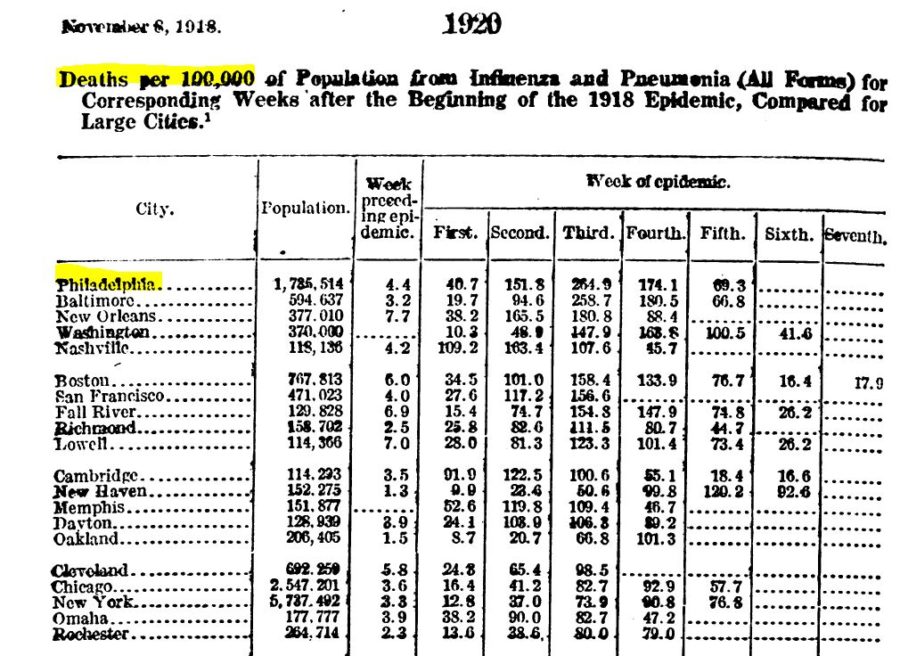
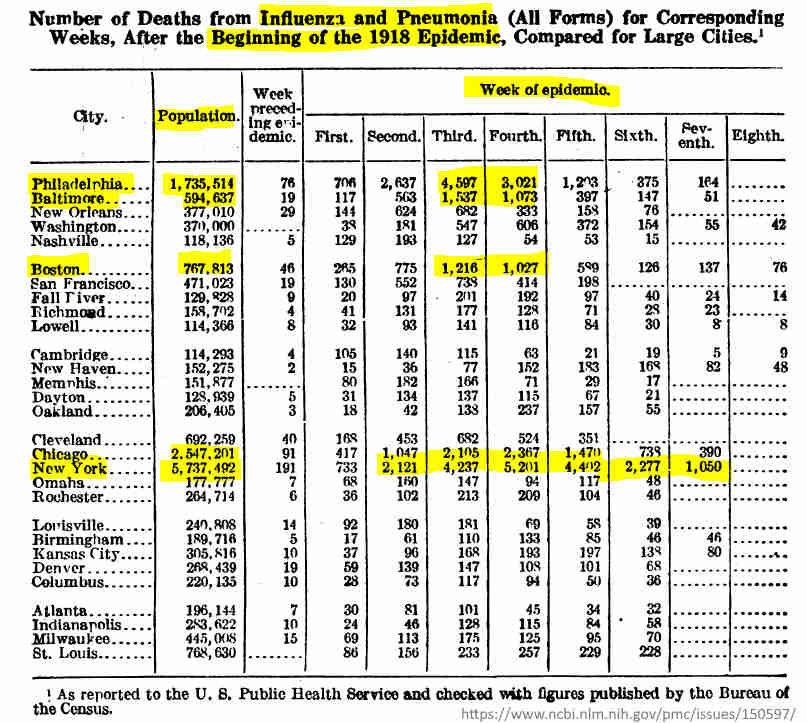
2021
May 24, 2021 – The Atlantic: A Clue to Why the 1918 Pandemic Came Back Stronger Than Before – Three 103-year-old-lung samples hinted at how the flu mutated to become more deadly. – READ
- Sébastien Calvignac-Spencer, a virologist at the Robert Koch Institute, in Berlin,…stumbled upon several lung specimens from 1918…”Despite the flu pandemic’s notoriety, the virus that caused it is still poorly understood.”
- “Calvignac-Spencer and his colleagues ultimately tested 13 lung specimens and found evidence of flu in three. One was from a 17-year-old girl who died in Munich sometime in 1918. The two others were from teenage soldiers who both died in Berlin on June 27, 1918.” [This date is before the “deadly” part of the pandemic?]
- “The team was able to recover a complete flu-virus genome from the 17-year-old girl’s lung tissue—only the third ever found”
- May 14, 2021 – BioRxiv pre print: Archival influenza virus genomes from Europe reveal genomic and phenotypic variability during the 1918 pandemic by Patrono et al (includes Jeffery K Taubenberger, David Morens) – READ, Now peer reviewed in Nature Communications – READ

